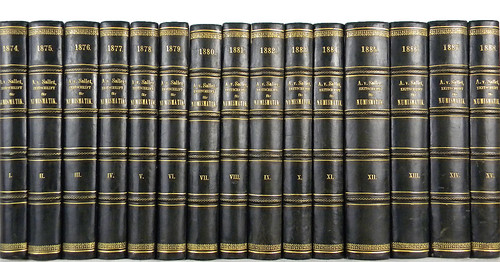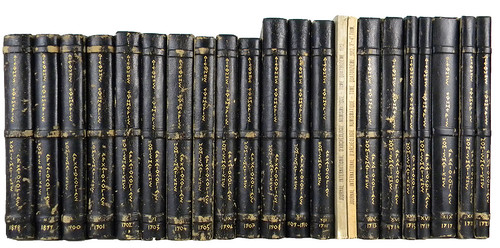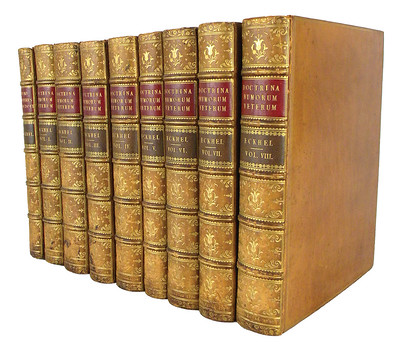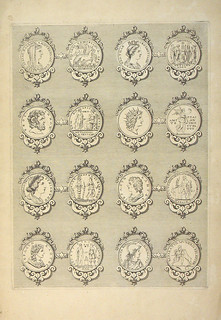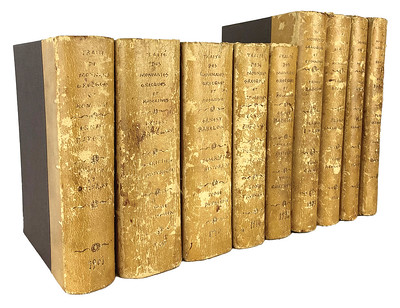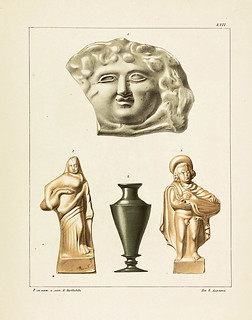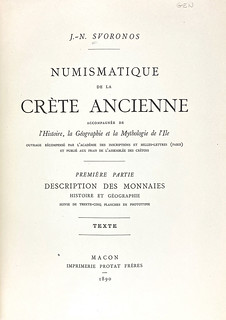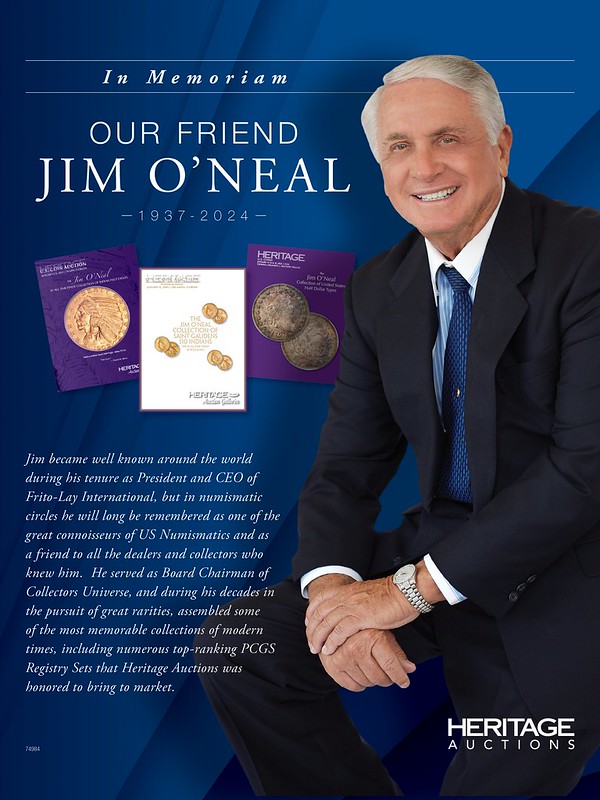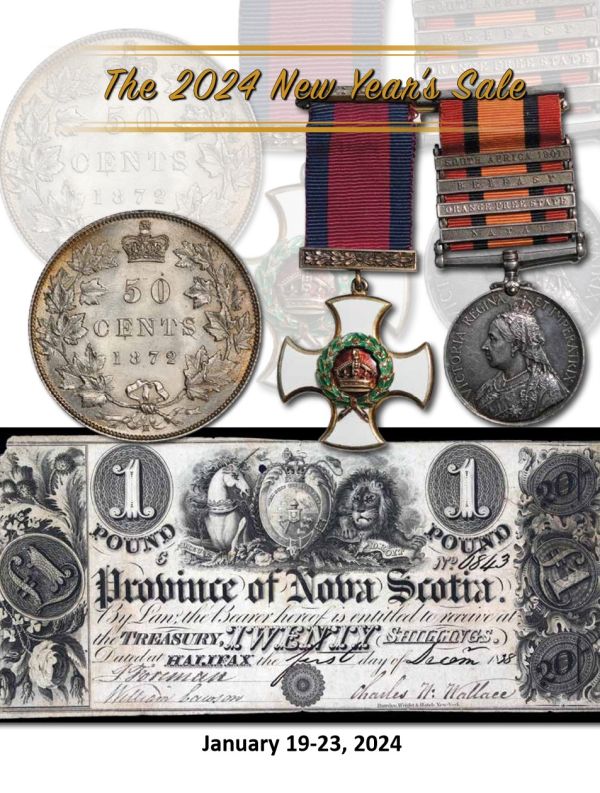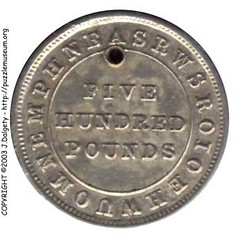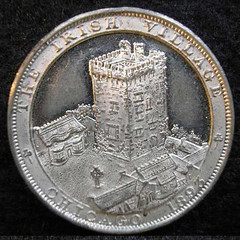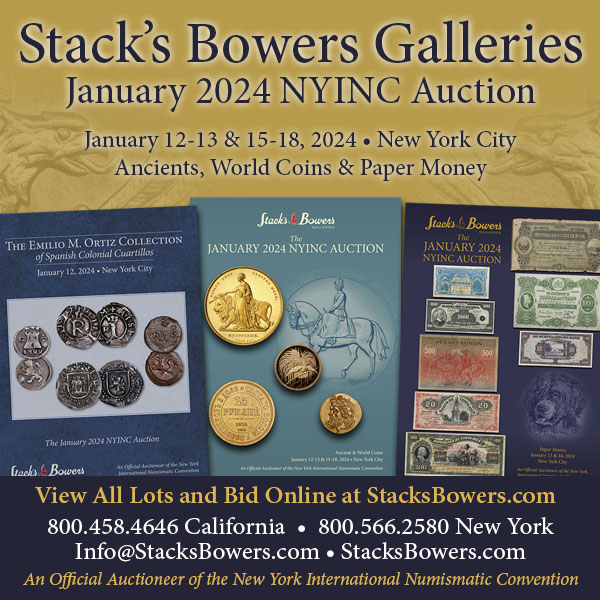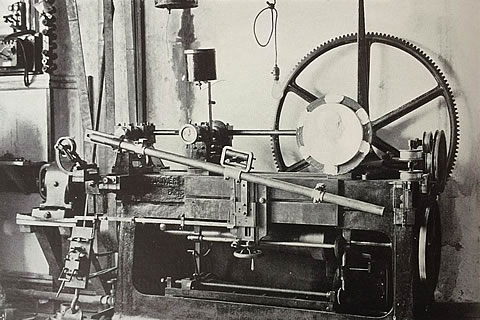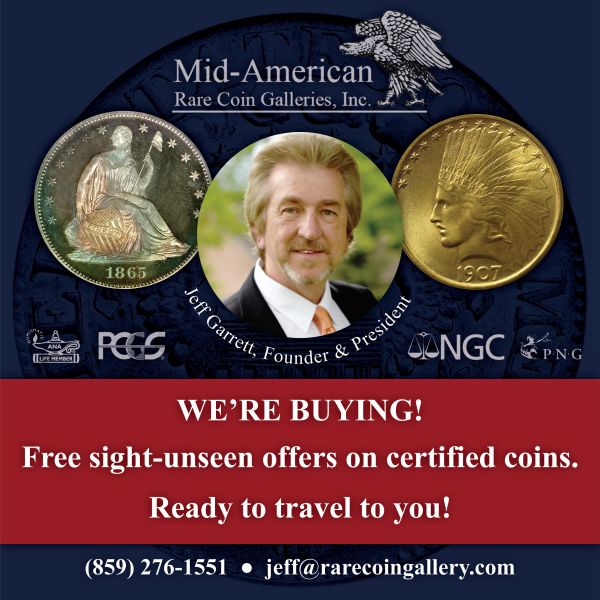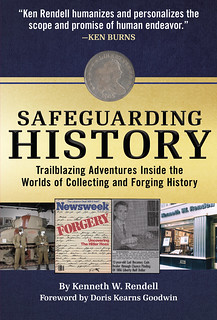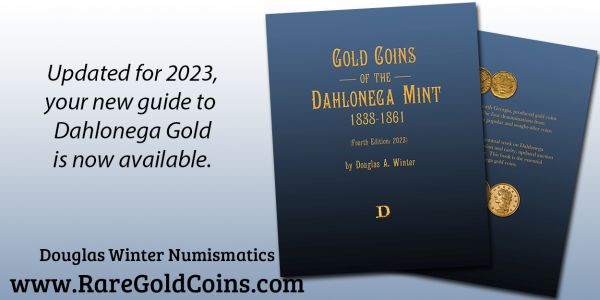
Visit our NBS Sponsors
About UsThe Numismatic Bibliomania Society is a non-profit association devoted to the study and enjoyment of numismatic literature. For more information please see our web site at coinbooks.org SubscriptionsThose wishing to become new E-Sylum subscribers (or wishing to Unsubscribe) can go to the following web page link MembershipThere is a membership application available on the web site Membership Application To join, print the application and return it with your check to the address printed on the application. Print/Digital membership is $40 to addresses in the U.S., and $60 elsewhere. A digital-only membership is available for $25. For those without web access, write to: Jeff Dickerson, Treasurer AsylumFor Asylum mailing address changes and other membership questions, contact Jeff at this email address: treasurer@coinbooks.org SubmissionsTo submit items for publication in The E-Sylum, write to the Editor at this address: whomren@gmail.com BUY THE BOOK BEFORE THE COINSale Calendar |
- WAYNE'S WORDS: THE E-SYLUM JANUARY 21, 2024
- INVASION OF CHAMPAIGN (PART 2)
- KOLBE & FANNING BCD LIBRARY SALE
- PETER DAVID MITCHELL (1933-2024)
- VIDEO: ANA AND ANACS IN 1985
- EDMOND JOHNSON'S PLAYFAIR CIPHERS
- NOTES FROM E-SYLUM READERS: JANUARY 21, 2024
- NEW JERSEY NUMISMATIC SOCIETY ARCHIVES
- DANSCO LIBRARY AND PRESERVATION UPDATE
- VOCABULARY TERM: PANTOGRAPH, PART TWO
- THE GREAT DENVER MINT ROBBERY
- TOM CALDWELL INTERVIEW, PART FOUR
- DR. PETER VAN ALFEN TO CHAIR CCAC
- WHY BANKNOTES LOOK AS THEY DO
- NUMISMAGRAM MEDAL SELECTIONS: JANUARY 21, 2024
- LII COLLECTION OF HISTORICAL COINS AND MEDALS
- NOONAN'S OFFERS SCOTTISH COIN COLLECTION
- STACK'S BOWERS TO SELL JOHNSON COLLECTION
- NUMISMATIC NUGGETS: JANUARY 21, 2024
- WAYNE'S NUMISMATIC DIARY JANUARY 21, 2024
- 7TH CENTURY BC COIN-WEIGHT FOUND
- FRANCE MELTS NEW EU COINS
- SCIENCE BEHIND FRANKLIN'S MONEY PRINTING
- STRAWBERRY SCRIP
- LOOSE CHANGE: JANUARY 21, 2024
Content presented in The E-Sylum is not necessarily researched or independently fact-checked, and views expressed do not necessarily represent those of the Numismatic Bibliomania Society.
WAYNE'S WORDS: THE E-SYLUM JANUARY 21, 2024
 New subscribers this week include:
Denis Richard - Coin Photography Studio.
Welcome aboard! We now have 7,471 subscribers.
New subscribers this week include:
Denis Richard - Coin Photography Studio.
Welcome aboard! We now have 7,471 subscribers.
Thank you for reading The E-Sylum. If you enjoy it, please send me the email addresses of friends you think may enjoy it as well and I'll send them a subscription. Contact me at whomren@gmail.com anytime regarding your subscription, or questions, comments or suggestions about our content.
This week we open with a chance to revisit the Invasion of Champaign, a numismatic literature sale, an obituary, a great 1985 video, and more.
Other topics this week include ANACS, the CCAC, Playfair Ciphers, the New Jersey Numismatic Society, Dansco albums, the 1922 Denver Mint robbery, fixed price and auction previews, Ben Franklin's money, and strawberry scrip.
To learn more about the extraordinary BCD Library, Peter Mitchell, Adna Wilde, Ed Price, Mexican Numismatics, the 1913 Liberty nickel, the James II and the Seven Bishops medal, the Hyman Montagu Collection, the Nine Siliquae denomination, and money-themed tattoos, read on. Have a great week, everyone!
Wayne Homren
Editor, The E-Sylum
THE BOOK BAZARRE
INVASION OF CHAMPAIGN (PART 2)
Len Augsburger is President of our host organization, the Numismatic Bibliomania Society. Please contact him if you're interested in touring the Dan Hamelberg numismatic library in conjunction with this summer's American Numismatic Association World's Fair of Money. -Editor
Invasion of Champaign (Part 2)
NBSers no doubt recall the Invasion of Champaign held August 20, 2019, in conjunction with the ANA convention in Rosemont, IL. This tour of the Dan Hamelberg library attracted about 15 visitors who trekked from the convention site to visit this unparalleled collection of American numismatic literature. The Fall 2019 Asylum included a full report of the event.
This year's ANA convention brings another such opportunity, and we invite feedback from readers as to which day might be optimal for a repeat visit. A few options are Monday, August 6, or Tuesday, August 7, prior to the ANA convention, or, on the back end, either Saturday, August 10, or Sunday, August 11. The drive from Rosemont to Champaign is about two and a half hours, and transportation will be provided by the NBS. Pickup in Rosemont will be at 9:30 AM with a return around 7:00 PM. Should you have any interest in such a tour, please contact NBS president Len Augsburger at leonard.augsburger@wustl.edu with your preferred date.
Image: Group photo from the 2019 Invasion of Champaign
Link to the Fall 2019 Asylum:
https://nnp.wustl.edu/library/publisherdetail/2101?Year=2019&displayAmt=50
Link to the 2019 Invasion of Champaign
video:
https://nnp.wustl.edu/library/book/567853
KOLBE & FANNING BCD LIBRARY SALE
Kolbe & Fanning announces their first sale of the blockbuster BCD Library of numismatics of the ancient world. Here are some highlights. -Editor
Kolbe & Fanning Numismatic Booksellers are pleased to announce that we will be offering for sale by auction the extraordinary BCD Library on numismatics of the ancient world, with the first sale to be held on Saturday, February 17. The BCD Library is famous for its extraordinary depth, particularly in works on ancient Greek coinage. Carefully formed over the course of half a century, the library has become a resource familiar to experts around the world through the generosity of the owner in making his library available for their use. This initial auction focuses most heavily on published collections, general works, periodicals, and landmark publications, with literally thousands of titles remaining for future offerings. The online catalogue can be accessed at bid.numislit.com.
Some highlights of this first sale include:
Lot 107: a complete set of the Zeitschrift für Numismatik (1874–1935), only of only a few such sets in private hands
Lot 126: J.N. Svoronos's classic Journal international d'archéologie numismatique, a complete set of this important and well-illustrated publication
Lot 165: an original, first edition set of Joseph Eckhel's Doctrina numorum veterum (1792–1798), finely bound in the 1840s by the London firm of Clarke & Bedford
Lot 177: T.E. Mionnet's 1806–1837 Description de médailles antiques, grecques et romaines, complete in sixteen volumes including the supplement and plates
Lot 197: the extremely rare folio volume (c. 1679) of 41 exceptional engraved plates depicting ancient coins in the collection of Louis XIV, part of the Cabinet du roi series
Lot 311: Jean Babelon's charming and very rare catalogue of the outstanding collection formed by Carlos de Beistegui, with 64 very fine plates
Lot 258: a complete, original set of Ernest Babelon's Traité des monnaies grecques et romaines (1901–1932), one of the landmark works in Greek numismatics
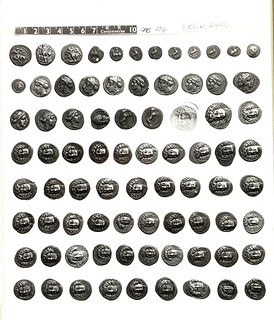 Lot 327: three volumes bringing together 146 unpublished photographic prints depicting over 5000 ancient Greek coins in the collection of the British Museum
Lot 327: three volumes bringing together 146 unpublished photographic prints depicting over 5000 ancient Greek coins in the collection of the British Museum
Lot 353: Edward Newell's copy of Bernhard von Köhne's rare catalogue of the Prince Basil Kotchoubey collection, published in Saint Petersburg in 1857
Lot 518: the first edition of Svoronos's 1890 Numismatique de la Crète ancienne, the author's first major work and still a vitally important reference.
Register early to bid online
Bids may be placed via post, email, phone, as well as online. Kolbe & Fanning use Auction Mobility as our third-party online bidding platform. Auction Mobility is an app-based platform allowing users the ability to participate in the sale through phones, tablets and computers. To register for the sale, bidders must go to
bid.numislit.com and sign up. Once you have set up an account, you may browse lots, place advance bids, or participate in the live sale online. Those wishing to participate on their devices can download the Kolbe & Fanning app through the Apple or Google Play Store. The sale will also be listed on Biddr and NumisBids in the near future.
To bid and view lots, see:
https://bid.numislit.com/
To view the catalogie PDF, see:
https://numislit.cdn.bibliopolis.com/images/upload/sale169-bcd-small.pdf
The printed catalogue is being mailed to all active customers on our mailing list. As international mail speeds have been inconsistent, we encourage our foreign clients to consult the electronic catalogue in case their printed catalogue does not arrive promptly. A PDF of the printed catalogue has been posted to our main website at numislit.com for those who prefer that format. Bids placed via post, email, or phone must be received by February 16, the day before the sale, in order for them to be processed. Advance absentee bids may also be placed at any time online at bid.numislit.com. Live internet bidding will be available during the sale itself through the same platform.
Kolbe & Fanning Numismatic Booksellers LLC is a licensed and bonded auction firm in the State of Ohio, and our sales are conducted by licensed auctioneers. For more information, please see the Kolbe & Fanning website at numislit.com or email David Fanning at df@numislit.com. To register for the sale, go to bid.numislit.com. We look forward to your participation.
PETER DAVID MITCHELL (1933-2024)
Charlie Riley and Ken Eckardt submitted this obituary and remembrance of Peter Mitchell. Thank you. -Editor
by Charlie Riley and Ken Eckardt
 Peter Mitchell died at home in Surrey, England, on Sunday morning, 14th
January 2024 aged 90, in the presence of his wife Jean. He had suffered
ill health for a while.
Peter Mitchell died at home in Surrey, England, on Sunday morning, 14th
January 2024 aged 90, in the presence of his wife Jean. He had suffered
ill health for a while.
Peter was the longtime managing director of well-known coin dealers A H Baldwin & Sons Ltd of The Adelphi, central London. He joined the family firm fresh out of school (Hampton Grammar) aged 15 in 1949 as the ‘office boy'. His father Douglas Mitchell worked there and Peter was a great grandson of founder Albert Henry Baldwin. His early years at Baldwin's were interrupted by National Service in the army, but Peter had the good luck to be posted to Hong Kong. While there the famous collector of British colonial coins, Captain (later Major) Fred Pridmore, travelled up from Singapore (where he was stationed with the army) to visit him in 1952, the start of a long association between them. Peter only retired from Baldwin's in 1997 (before joining auctioneers Dix Noonan Webb as a consultant). He was to become one of the great British numismatists of his time, including cataloguing many famous sales for auction at Glendining's, Christie's, Sotheby and Spink (for example O'Byrne, Fred Pridmore, Virgil Brand, Dick Ford, Ralph Gordon, John J Ford cut and countermarked West Indian, among many others).
He will probably best be remembered for his expertise in British hammered coinage and interest in the cut and countermarked series of the West Indies, but his knowledge was much wider than this. He was a great supporter of the ‘Erik Group' (so named from the first name initials of its members: Edward, Ralph, Isaac, Ken), a group of four serious collectors of West Indian cut and countermarked coins – to the extent that he joined them for memorable meetings in the Dominican Republic and Puerto Rico on one trip. He was assiduous in helping clients in the formation of their collections, possibly in the hope that in due course they might sell back to the firm directly rather than go through auction, but more likely that he was an old-fashioned dealer who simply loved assisting collectors. He enjoyed mixing business and pleasure – typically after a major ‘named' auction he would host the principal collectors and dealers who had travelled to London for the sale to a lavish dinner afterwards.
In 1967 on the death of Albert Baldwin, Peter took over the day-to-day running of Baldwin's. In 1973 the introduction of VAT was around the corner and this prompted Peter and others (notably Patrick Finn of Spink and Peter Seaby of the eponymous firm) to found the British Numismatic Trade Association, of which in due course he became a life member in recognition of his role in its creation (he was also made an honorary member of the British Numismatic Society). His working relationship with Patrick was close: Peter mentioned that first thing every weekday morning, Patrick and he would speak to each other on the phone to discuss what they saw as any problems or issues of mutual interest facing the coin business, such was the trust between the heads of Baldwin and Spink's coin department at that time.
In the absence of a definitive history of Baldwin's, we have Peter's
Some Reminiscences of the Coin Business I joined and of some
members past
(British Numismatic Journal 2003, pp197-212). From
this, as if any reminder were needed, we see that Peter had an
encyclopaedic knowledge not only of coins, but also the major collectors
of his day (although in the article he only covers those who were
members of the British Numismatic Society). He also had many good
stories to tell, but as someone once said, the best tales can never be
retold in print! There is also the reminder of old Baldwin traditions, such
as naming major clients by just a three figure number, to ensure
confidentiality in the office in case others should overhear.
Charles Riley's memories of PDM, whom he first really got to know in 1990, are without fail good ones. Peter had a good sense of humour, although by his own admission it could be ‘perverse' and was good for a drink in a bar or pub, although when he got carried away he had a habit of punching one's arm so that at the end of the evening it felt as though you'd spent it in a boxing ring. From 1994 Riley worked in a junior capacity for Baldwin's at Adelphi Terrace and saw first-hand how well he treated the staff (which was not always typical of some other management there at that time, unfortunately). In midlife, rather curiously, Peter took up competitive rowing at Molesey Boat Club, an interest which extended to attending Henley Regatta every year in the Stewards' Enclosure. In recent years Charlie and Peter had some enjoyable correspondence by post, in which Peter expressed forthright opinions about certain individuals – but almost certainly these will not be for publication!
Peter's first marriage was to Feiona, with whom he had a son and a daughter. The marriage was dissolved in 2001 and late in life he married his childhood sweetheart Jean, who survives him, along with his children from his first marriage and grandchildren.
Peter made an immense contribution to numismatics in the United Kingdom and beyond, as well as adding to the gaiety of life. He was one of the key numismatists of his generation and will be long remembered by all who knew him. With his passing it is not a cliché to say that it is the end of a numismatic era. He will be missed.
VIDEO: ANA AND ANACS IN 1985
The David Lisot Video Library on the Newman Numismatic Portal can be found at:
https://nnp.wustl.edu/library/multimediadetail/522852
We highlight one of his videos each week in The E-Sylum. Here's one from 1985 about the American Numismatic Association and the ANACS service. -Editor
Rick Montgomery and Adna Wilde of ANACS grading service talk about coin authentication. Then additional programs with Ruthann Brettell, Robert Hoge, and Nancy Green of the American Numismatic Association staff.
This one's a real gem. The segment includes public service announcement videos for the Royal Canadian Mint and ANA, plus a video of workers at ANACS. What a great time capsule! -Editor
There is a segment on the ANA Museum, and for bibliophiles, ANA Librarian presents a video tour of the library. -Editor
To watch the complete video, see:
Collector Talk: American Numismatic Association
(https://nnp.wustl.edu/library/book/584161)
EDMOND JOHNSON'S PLAYFAIR CIPHERS
Julia Casey submitted these notes on jeweler Edmond Johnson and his puzzle tokens. Thank you! -Editor
I've not been able to crack Edmond Johnson's puzzle tokens, but I wanted to write in with some additional information. I decided to first approach Johnson by way of contemporary reports of the 1893 Chicago Columbian Exposition, in the hope that there would be some mention of his tokens.
While I did not find any token references, I did find reports of Johnson's exhibits of reproductions of ancient Irish jewelry and artifacts. Later, some of his replicas of Irish antiquities were sold to a Chicago museum and ended up in the Spurlock Museum at the University of Illinois. You can see Johnson's magnificent copy of the Ardagh Chalice and other items on their website. The museum has also made available a copy of Johnson's descriptive catalog via the HathiTrust site.
Reproductions of Irish cultural icons on display at Spurlock Museum (https://news.illinois.edu/view/6367/408999)
Illustrated supplement to the descriptive catalogue published by Edmond Johnson ... of fac-simile reproductions of Irish antique art metal work (https://babel.hathitrust.org/cgi/pt?id=uiuc.7969286&seq=12)
The only newspaper mention I found about the puzzles was from the August 8, 1946, Belfast Newsletter. A reader asked for information about the Johnson Jeweller Dublin
token and said that it was picked up in the London street in 1910.
Since I hit a dead end with contemporary references I decided to see if I could figure out how the puzzles were meant to be solved. I've determined that these pieces are something called a Playfair Cipher
As of 2020, Klaus Schmeh's website ScienceBlogs
indicated that the world record for solving a Playfair Cipher without a key is 26 letters. Since both of Johnson's puzzles are 22 letters, we may have a problem!
I also came across a program that works out solutions to Playfair Ciphers. I've had some fun with it but no eureka moments so far.
Playfair cipher (https://en.wikipedia.org/wiki/Playfair_cipher)
Can you solve this Playfair cryptogram and set a new world record? (https://scienceblogs.de/klausis-krypto-kolumne/2020/01/27/can-you-solve-this-playfair-cryptogram-and-set-a-new-world-record-3/)
Playfair PH solver using Web Workers (https://bionsgadgets.appspot.com/ww_forms/playfair_ph_web_worker3.html)
Johnson wasn't playing fair if his 22-letter puzzles were unsolvable. But it's a harmless bit of fun and a great advertising ploy, not unlike dealer B. Max Mehl's offer of $50 for a 1913 Liberty Head Nickel. Only five were made and all examples were in known hands, but it got the public at large looking through their change and buying copies of his Star Rare Coin Encyclopedia.
Thanks again to Gawain O'Connor for bringing these interesting pieces to our attention. -Editor
To read the earlier E-Sylum articles, see:
UNSOLVED NUMISMATIC PUZZLES FROM DUBLIN
(https://www.coinbooks.org/v27/esylum_v27n01a09.html)
MORE ON DUBLIN JEWELLER EDMUND JOHNSON
(https://www.coinbooks.org/v27/esylum_v27n02a08.html)
NOTES FROM E-SYLUM READERS: JANUARY 21, 2024
 Photo Fix
Photo Fix
Ken Spindler writes:
"The image of the Hungarian coin that you were sent for that very interesting article by Tom Babinszki, is the wrong side of the coin for the AI description. That coin is a KM-689 (200 forint, 1992-1993). Based on the way KM has the pix arranged, the image shown is of the obverse of the coin, but the computer's description is of the reverse."
Tom writes:
"Thank you so much for pointing it out, what I read from was a file on my hard drive, and I later added the wrong image, it should be fixed now."
It's indeed fixed on Tom's blog now, and our webmaster Bruce Perdue has updated the E-Sylum archive as well. Thanks, everyone. Here's the correct image. -Editor
To read the earlier E-Sylum article, see:
RECOGNIZING COINS WITH ARTIFICIAL INTELLIGENCE
(https://www.coinbooks.org/v27/esylum_v27n02a11.html)
More on the Mint Fire of 1816
"The Stacks Bowers post about the Mint fire of 1816 was interesting, but it left out what I think is the most interesting part of the story.
"During the first 10 days of January, the Mint had been busy striking 20,003 quarters and 147,150 half dollars. All were dated 1815 using dies that were left over. The fire conveniently happened right after the silver coins were delivered. No more could be produced until the Mint acquired new rolling mills, which did not happen until 1817.
"Copper coins could be struck from planchets received in late 1815, and quantities were delivered to the treasurer on February 3, 20 and 26. What is most interesting about these coins is that they were all dated 1814 and were of the Classic Head type. The new Matron Head design was implemented several months later. We know this because the surviving number of 1814 cents is far too high relative to that of the other Classic Heads, if the reported mintages are accurate. Similarly, the surviving number of 1816-dated cents is too low relative to the other Matron Heads of the period.
"Why did the mint strike cents with an obsolete date in 1816? We can only speculate, but it seems most likely that there had been no planning to introduce a new cent type in the first few days of 1816, so no new master dies had been produced. The early cent coinage of 1816 was a contingency to keep the mint workers busy when no gold or silver coins could be produced. Because of this, specialists who collect 1816 cents now sometimes add the 1814 Plain 4 variety to their sets.
For a full explanation, see Bill's article in The Numismatist, May, 2018, beginning on page 54. -Editor
To read the earlier E-Sylum article, see:
THE JANUARY 1816 U.S. MINT FIRE
(https://www.coinbooks.org/v27/esylum_v27n02a22.html)
El Dato. Numismática de México
"A new social media page is available on Facebook dedicated only to divulge information of Mexican Numismatics of all topics. I invite you to follow the page:
https://facebook.com/profile.php?id=61555370542876."
Bibliophiles note - the page includes a number of recommendations of books on Mexican numismatics. -Editor
Will the Real Ruggles Sylvester Torrey Please Stand Up?
Jud Petrie writes:
"I read with interest the latest E-Sylum and wanted to comment on biographical/genealogical references made by Jim Haas. I wrote an article and won the 1st place Literary Award for the Civil War Token Society in 1992 about the only issuer of a Civil War token from Maine, R.S.Torrey. In my article I noted contradictory information including different dates of death. As it turns out, there were 2 men living about 75 miles apart at the same time with the same very unusual name of Ruggles Sylvester Torrey. Of course I wrote about the wrong one. The issuer of the token was a scoundrel who preyed upon women but the one I wrote about was an upstanding citizen, and the last hangman in Maine. I offered to return my award but my offer was denied. And as Mr. Haas said "Live and learn"."
Wow - that's how stuff happens. It's a rough world out there for researchers. I added an image of one of Torrey's tokens from Steve Hayden's site. -Editor
To read the complete lot description, see:
Bangor Maine Civil War token ME100A-2a
(https://www.civilwartokens.com/Listing/Details/510594/Bangor-Maine-Civil-War-token-ME100A2a)
To read the earlier E-Sylum article, see:
NOTES FROM E-SYLUM READERS: JANUARY 14, 2024 : On Researching Biographical Information
(https://www.coinbooks.org/v27/esylum_v27n02a09.html)
More on the 1588 Dutch Medal
Bob Shippee writes:
"You posted an item about a "paperweight" replica of a 1588 Dutch medal. Here's what I found in my English language version of Gerard Van Loon's "MEDALLIC HISTORY OF THE LOW COUNTRIES (1555-1716), VOL. I: 1555-1602" on page I•311. In summary, a stunning Dutch medal commemorating a catastrophic defeat of the Spanish war fleet."
Thanks - great medal commemorating a landmark historical event. -Editor
To read the earlier E-Sylum articles, see:
NUMISMATIC NUGGETS: JANUARY 7, 2024 : Dutch Naval Fleet Medal Paperweight
(https://www.coinbooks.org/v27/esylum_v27n01a19.html)
DUTCH DEFEAT OF THE SPANISH ARMADA MEDAL
(https://www.coinbooks.org/v27/esylum_v27n02a07.html)
Grading Service Experiences
Anthony Terranova writes:
"I'm in business 50 years now. Had my first terrible experience at a coin show, with the service PMG. Sent in seven great early notes for their service. Was charged amazingly high fees totaling over $5,000. Got six of them back at the tail end of the FUN show. One of them was apparently sent back to their offices in Sarasota. I'm still waiting for it to be sent to me. Called them several times and received the same stock answer on its way to the shipping department
. Disappointed and disgusted..."
FUN was quite a busy show from the reports I've seen. Not being a regular user of grading services, I'm unfamiliar with today's fee structures, and we generally avoid discussions of grading and pricing to focus on numismatics. But hobby history is fair game. Is anything new going on in today's market? -Editor
NEW JERSEY NUMISMATIC SOCIETY ARCHIVES
Jeff Burke submitted this article based on the archives of the New Jersey Numismatic Society (NJNS). Thank you! -Editor
I joined the New Jersey Numismatic Society (NJNS) in 2013 and took over as Society Secretary after Dave Ginsburg's untimely passing in 2016. Ginsburg was a brilliant numismatist. I often marveled that he sometimes knew more about topics presented by distinguished guest speakers at our meetings than did the presenters.
Dave and I shared a passion for numismatic research, writing and publication. I miss having conversations with him about numismatic books and our latest research pursuits. On that note, I will turn to my current research project.
I was curious to see the NJNS archival holdings, so NJNS President Pete LaConte gave one box of documents to me after our September 2023 NJNS meeting. It was exciting to open the box and begin examining the contents over the December/January holiday period! I found copies of The Numismatist from 1933 and 1934, NJNS membership rosters dating to 1944, auction catalogs, a notebook of NJNS newsletters, a 1958 issue of The Flying Eaglet Numismatic Magazine, elegant NJNS annual and anniversary dinner menus, yellowed Northwest New Jersey Daily Record numismatic articles published by Harold Flartey, correspondence, photographs of NJNS members, awards bestowed upon the NJNS by the American Numismatic Association (ANA) and the Garden State Numismatic Association (GSNA), and other documents.
From the archives, I learned about another founding member, Jim Wade, thanks to an enclosed letter and note that Ed Price mailed to Harry Rescigno on May 24, 1999 (for more information about Ed Price, see postscript). The smaller inside envelope contained a letter from Jim Wade to Charles F. Nettleship, dated May 29, 1950. An inscription on the top left of the interior letter reads Jim Wade was a founding member of NJNS.
Price included an index card in the mailing which mentioned Harry – I thought this might be useful for the archives . . . .
The New Jersey Numismatic Society was founded in October 1933, with C.F. Nettleship, Jr., being selected to serve as Chairman of the new organization. Gladys Wade was selected as Secretary. (The Numismatist, Dec. 1933, p. 794).
In his 2008 President's letter marking the 75th anniversary of the NJNS, Harry Rescigno noted: The NJNS is dedicated to the advancement of numismatics through the study of the history, manufacture and art of coins, paper money and exonumia. Throughout the years, the NJNS has been privileged to have had many notable numismatists such as: F.C.C. Boyd, Henry Christensen, Willard Blaisdell, Henry C. Hines, Dr. Stanley Sherr, Herbert Oechsner, Ernest Kuesch, Herb Silberman, Robert Schonwalter, Harold Flartey, Christopher Connell, William Moore, George Wait and many more, as members. NJNS members have been active in other organizations, with many serving as Fellows of the American Numismatic Society and Board Members of the American Numismatic Association.
Dr. Michael Fey served on the ANA Board of Governors from 2005 to 2007.
These are some NJNS guest speaker highlights from the archive:
-
Leland Howard, assistant U.S. mint director was the guest speaker at the ‘New Jersey Numismatic Society' dinner, this was the society's (25) Anniversary, held at the ‘Robert Treat' Hotel in Newark.
Howard gave a speech on theprocess and general production of our coins and currency.
(The Flying Eaglet Numismatic Magazine, May 3, 1958, p. 3). -
Robert W. Julian was the special guest speaker for the 529th meeting of the NJNS on June 17, 1985. The topic of his lecture was
Medals of the United States Mint: 1792-1892.
(NJNS Newsletter, June 1985). -
Dr. David Menchell was the speaker on the occasion of the 800th meeting of the NJNS. Menchell's topic was
American Colonial Medals as Catalogued by Betts.
(NJNS souvenir card, December 20, 2004).
 In addition, NJNS members were active in producing numismatic books and articles, presentations, show exhibits, serving as officers of numismatic organizations, and many other activities. For example:
In addition, NJNS members were active in producing numismatic books and articles, presentations, show exhibits, serving as officers of numismatic organizations, and many other activities. For example:
-
Three NJNS members . . . served on the U.S. Assay Commission: Founder Charles Nettleship (1937), Past President Vernon Brown (1942) and Joseph Litvany (1965).
(The Numismatist, May 1983, pp. 953-954). - Vernon L. Brown was Curator of the Money Museum of the Chase Bank of New York. (The Flying Eaglet, May 3, 1958, p. 10.).
- Herb Silberman founded the Early American Coppers specialty club in 1967.
- Ray Williams was President of the Colonial Coin Collectors Club from 2000 to 2010. Ray also has been writing a quarterly column on colonial numismatics for The Numismatist since 2016.
(Dave Bailey served as President of the Garden State Numismatic Association from 2008 to 2018).
-
Club member George Wait compiled a massive volume entitled New Jersey's Money for the Newark Museum.
(The Numismatist, May 1983, p. 953). - James K. Brandt served as President of the 27th Annual Metropolitan Numismatic Convention (Spinx & Son USA Auction catalogue No. 3 March 24-26, 1983, p. 5).
-
Our friends Ernest Keusch and Robert W. Julian are gathering research data for a forthcoming reference on Assay Commission Medals.
(The Collection of David W. Dreyfuss Auction Catalogue, Bowers and Merena, Inc., and the Presidential Coin and Antique Company, Inc., Metropolitan New York Numismatic Convention, April 12, 1986, p. 13).
A number of NJNS members have won prestigious ANA Awards including George Blake, David Lange, Chris Connell, James K. Brandt, Ron Thompson, Ray Williams, Michael Fey, and others. The following NJNS members are former or present members of the Numismatic Literary Guild: Harold Flartey, Chris Connell, Harry Rescigno, Arno Safran, David Lange, Ray Williams and Jeff Burke.
Some NJNS members assembled coin collections that were major contributions to numismatic inquiry and learning. For example, Carl Feldman owned 98 of the 120 known die varieties of the early dollars, minted from 1794 to 1803.
Also, while reading through the NJNS archival documents, I observed that we have had members of the NJNS who were also members of the New York Numismatic Club (NYNC), such as F.C.C. Boyd, George Blake, Axel Julius de Lagerberg (see his obituary in The Numismatist, 1936), Damon G. Douglas, Susan Douglas, Herb Oechsner, Ernest Kuesch and Robert Schonwalter. Damon Douglas served as President of the NYNC from 1949 to 1951. Douglas had a presidential medal issued after his tenure. There are probably other names to be added to this list. However, the NJNS archives are scant between the mid-1930s through the 1970s. More recently, there have been other members of both organizations, as well.
Future research suggestions to find numismatists who were members of the NJNS and the NYNC include checking club reports for each month in The Numismatist starting in 1933, and reading through obituaries. Scott Miller recommends referring to Pete Smith's American Numismatic Biographies and conducting searches on the Newman Numismatic Portal. Miller also mentioned that a NYNC membership list can be found in An Island of Civility, The Centennial History of the New York Numismatic Club 1908/09-2008/9, by John M. Kleeberg and David T. Alexander, published by the NYNC in 2009. I loved reading this book from cover to cover a few years ago!
Conclusion
I was struck by the wide range of service to numismatics provided by our Society members at the local, state, regional and national levels. I feel inspired by their level of dedication and am considering what I can do to further promote the study of numismatics. As for now, I plan to put the NJNS papers in acid-free archival folders in an acid-free archival box for future preservation.
Postscript: Focus on Ed Price, Scholar of Bust Dimes and Early Quarter Eagles
Imagine the world of 1950, when Ed Price began to collect contemporary circulating coins as an eight-year-old. Ed graduated from Yale University in 1964 and began to assemble a U.S. type collection of coins in 1970. After selling the lion's share of his type collection in 1988, Ed began a decade long pursuit of studying and assembling early Federal coinage, with a focus on half dime and early dime varieties. (Heritage Press Release, March 4, 2008).
Ed Price joined the NJNS in 1991 and was an active member in the early 1990s. Various NJNS members reflected on how Ed encouraged other numismatists to see first-hand and learn about his numismatic treasures. I remember him as a real gentleman who generously shared his fabulous collection with the NJNS members while he had it.
(David Lange email, September 22, 2019). Charlie Davis noted, his knowledge of bust dimes was extraordinary and the catalogue of his collection which opened my eyes to the fact that quarter eagles shared similar if not the same dies is one of my favorites.
(Charlie Davis email, September 22, 2019). Arno Safran had perhaps the most familiarity with Ed's coins: Back in 1994 at Ed's request, I photographed all of his early dimes the old-fashioned way on kodachrome slides. The fact that they were the same basic diameter as the $2.50 quarter eagles was also an interesting bit of knowledge Ed taught me. Ed was a highly intelligent and disciplined numismatist and although he was earning a considerable income as an insurance executive at the time, when it came to upgrading or buying expensive rare coins he would say, ‘One must sell in order to buy!'
(Arno Safran email, September 22, 2019).
Today, Ed Price is known for his incomparable variety collection of early Dimes and Quarter Eagles ... auctioned by Heritage ... at the Baltimore ANA, July 30-Aug. 2, 2008.
The Ed Price Collection was a complete collection by variety of both the early dimes and quarter eagles, featuring the common reverse dies, such as has never before been assembled.
(Heritage Press Release, March 4, 2008). The Ed Price unique collection of early dime and quarter eagle varieties sold for 5.7 million dollars. (NGC Newsletter, August 2008, p. 28).
The Heritage catalog for the Ed Price Collection is considered to be one of the most important references for the study and classification of early federal dimes and quarter eagles. Ed had his research on Bust dime and early quarter eagle die states and varieties published in the John Reich Journal. Refer to the Newman Numismatic Portal for more information on Price's research on bust dimes and early quarter eagles.
Acknowledgements: I am grateful to New Jersey Numismatic Society members who answered my questions and provided information for this article, including Charlie Davis, Arno Safran, Harry Rescigno, the late David Lange, Ray Williams, Scott Miller, Ron Thompson, and Pete LaConte.
DANSCO LIBRARY AND PRESERVATION UPDATE
Justin Hinh submitted this update on his ambitious Dansco album project. Thank you! -Editor
I wanted to share an update with you and your readers on my Dansco library and preservation project. As mentioned in my previous E-Sylum update, I had around 200 albums and was aiming to collect one of every album Dansco has ever produced. Today I am happy to report that I have now collected one of every album that Dansco has ever listed for sale in their catalog since 1939.
My collection now stands at over 700 albums & folders. Including prototype albums, vintage editions, and all of the Continental Line series.
 Readers can check out a video walkthrough of my library here on
Instagram.
Readers can check out a video walkthrough of my library here on
Instagram.
A big part of my collection recently came from the late David Lange's estate. His collection was quite extensive and I'm proud to say that they are now in my library. I am still keeping an eye out for odd and one-off custom albums that Dansco has made for various coin shops and clubs around the country. If readers happen to have one, please do reach out! I am working through documenting my collection and will update you when I am done.
 Lastly, if folks would like to learn more about Dansco and are happening to attend the ANA National Money Show in March, I will be giving a presentation about Dansco called "Guns, Gamblers & Grains: The Untold History of Dansco Specialty Albums".
Lastly, if folks would like to learn more about Dansco and are happening to attend the ANA National Money Show in March, I will be giving a presentation about Dansco called "Guns, Gamblers & Grains: The Untold History of Dansco Specialty Albums".
Impressive accomplishment - congratulations! As mentioned before, Dave Lange would be thrilled with this outcome. Thanks for carrying the torch forward. Check out the great video, and if you're in Colorado Springs for the National Money Show, be sure to see Justin's talk. -Editor
To watch the Instagram video, see:
Thre Dansco Dude Library - Over 700 Albums & Folders
(https://www.instagram.com/p/C2RY-sBuDf6/)
For more information on the ANA show, see:
https://www.money.org/nationalmoneyshow/
To read the earlier E-Sylum articles, see:
NOTES FROM E-SYLUM READERS: FEBRUARY 5, 2023 :
Dansco Albums Wanted
(https://www.coinbooks.org/v26/esylum_v26n06a12.html)
JUSTIN'S MULTI-STATE COIN SHOP TRIP
(https://www.coinbooks.org/v27/esylum_v27n02a10.html)
VOCABULARY TERM: PANTOGRAPH, PART TWO
Here's the second and final part of the Pantograph entry from Dick Johnson's Encyclopedia of Coin and Medal Terminology. -Editor
France's Contamin (again, no other name known, and his dates unknown) working in Paris created an improved machine with a rotating cutter, called a Tour de Médailles. This success led to widespread use of his machine. Probably developed prior to 1834, when Franklin Peale observed it that year. In 1836 Peale obtained the Contamin engraver for the United States Mint at Philadelphia. While not associated with the Paris Mint, Contamin was able to offer his machine to any buyer in any country, thus its influence was widespread.
A generation later, England's Charles John Hill first developed his machine in 1851 with further improvement in 1856. While he may have seen James Watt's improved diecutter at the Soho Mint, he most certainly had knowledge of the Contamin. Hill's die-engraving pantograph was patented in 1866 and at first he only wanted to do die-cutting reductions, preferring not to let the machine out of his control. It was only when William Wyon purchased Hill's machine, obtaining all rights to it that it could be sold to others. It was built and marketed by George Wailes & Company, a machinery manufacturing firm of Vauxhall.
Victor Janvier's period of developing his remarkable machine occurred in the 1890s. An accomplished medallist, he formed a partnership in 1892 with Paul Marie Duval to do custom enlarging and reducing, to cut dies, and even to manufacture medals. Undoubtedly his dissatisfaction with existing machines, notably Hill's and Contamin's, led to his experiments to improve the mechanics and to construct his own reducing lathe.
The problem with existing reducers was the speed of the revolving model and the die block. Janvier's solution was inspired. He provided a slow revolving speed of the model at the beginning when the tracer and cutting point were both in the center. At the end he needed just the opposite speed: greater speed of the model and slower rotation of the die.
He accomplished this by twin cone axis pointing in opposite directions with a belt connecting them. One axle drove the rotation of the model (this was slow at the beginning, increasing in speed as it reached the edge of the pattern). The other drove the rotating chuck holding the die block (it was rapid in the beginning and slower at the end). Neither of these affected the speed of the rotating cutter point (which was driven by a belt in some machines, by a separate motor in others). Janvier's concept was simple – a mechanical mechanism to effect the change in speeds at different stages of the die engraving progress – simple but highly effective. Janvier build his machines with the quality of a Swiss watch.
Janvier's improvements created a smooth running mechanism with watch-like accuracy. He was granted a French patent in1899 and he created a second business, Ateliers Victor Janvier, to commercialize on his invention by building and selling his die-engraving pantographs to mints and manufacturers throughout the world.
Janvier's machines sold but not without some persuasion. For example, the United States Mint at Philadelphia were still using their 50-year old Hill lathe – for portraits and devices as reduction punches – with decreasing satisfaction of the engraving department.
In New York City at the turn of the century a couple of German brothers who were in the ladies handbag business sent a new employee, French-born Henri Weil, to France to see why the metal decoration of French handbags were better than any other. Weil cabled the Deitsch Brothers, the decoration was made on the best reducing machine manufactured in Paris, a Janvier.
The Deitschs wired in return: "Buy machine. Learn its operation. Bring to New York." Weil did just that, bringing the machine back with him in 1906. This was the beginning of the Janvier in America and what was to become the Medallic Art Company.
The Deitsch brothers liked the machine so well they became the exclusive agents for Janvier in America. But it took the intervention of a sculptor, Augusts Saint-Gaudens, and a U.S. president – Theodore Roosevelt – to insist the U.S. Mint buy a Janvier to replace their Hill reducer. It did so in 1906. The Philadelphia Mint had been considering obtaining a new reducing machine for several years. The delay in buying one from Keller Mechanical Equipment Co., or some other, was the indecision by Engraver Charles Barber. The President's pressure forced their decision to obtain a Janvieer from the Deitsch Bros. in New York City.. Henri Weil, then an employee of the Deitschs, went to Philadelphia to instruct engraving department employees how to operate it.
Henri Weil and brother Felix were to later acquire the distribution rights of all Janvier's machines in the U.S. as a collateral business to their medal manufacturing (which continued until the 1960s) as part of Medallic Art Company, which they acquired from the Deitsch Brothers in 1909.
By 1921 Janvier's reputation was widespread and his reducing machines were in 22 countries around the world. The number built and shipped by country are listed in the adjacent box.
Ratios and Restrictions
Because the center axle of the model cannot be the same as the axle of the cutting tool, a reducing machine cannot cut a one-to-one replica. There must be space between the two axles (enough in fact for the chariots to hold the tooling for each). If the pattern isn't too large a ratio of 1.5-to-one can be cut on die-cutting pantographs. The more preferred ratio, however, is three- or four- or five-to-one.
Nevertheless, the limit of reduction is about ten-to-one on the more modern pantographs. Some reducing machines have been built, however, to accommodate a model-to-die ratio of as much as 20-to-1. Since most coins are 1 1/2-inch or smaller, their models are most often about 6 to 9 inches in diameter. Medals are somewhat larger; a medal 2 1/2 to 3-inch in diameter would best reduce from a 9 to 18-inch diameter model.
If the model is inordinately too large – or the desired die too small (as a charm size) – an intermediate reduction is made, cast into a new pattern and reduced again. Since this intermediate step most often is cut in beeswax or paraffin (for quick cutting in a material easily cut into a new pattern), this is often called a wax reduction.
Action of Pantograph Described
The diemaker must know the process for which a pair of dies are intended, he receives a work order which states the type of press and a diameter to cut the dies. He is also furnished a metal or epoxy pattern (dieshell) from which to cut the die. He will mount the pattern dieshell in the die-cutting machine (Janvier reducing machine or other diecutting pantograph). He will also mount a die block of proper diameter and thickness in the pantograph (die blocks are cut from roll stock or bar stock and face trimmed on both ends – these two surfaces must be parallel!). A diestock wider than the intended diameter of the medal is chosen (see chart).
A tracing point (stylus) is set to play over the face of the pattern, dieshell hubshell, its bas-relief contour allows the tracing point to rise and fall with the rise and fall of relief. This action is transferred to the cutting point by a long bar to which they are both attached. The distance from the centers of the two – dieshell and diestock – determines the percentage of reduction to effect the desired diameter of the image size, and thusly the diameter of the medal. (The ratio and this distance is critical to obtain the correct diameter image to be cut on the die.)
The mechanism of the pantograph is such that the stylus travels outward a tiny fraction of an inch while the dieshell is slowly rotating. Likewise the diestock is rotating at the same speed and the cutting point is actually cutting into the diestock the depth allowed by the bar guided by the pattern. Once it reaches its outermost position (to the edge of the relief of the pattern) it will automatically shut off. (Thus once a pantograph is set in motion and is performing satisfactorily it can run unattended by its operator, even into the night, or into the weekend – all machines are set to operate by Friday pm, on Monday morning all work is accomplished!). If cutting was interrupted such as by a power failure or broken tracing point, then entire work often had to be restarted from the beginning.
Without removing either the pattern or dieshell a second and third cut are performed in much the same manner. With each new setting a finer tracing stylus is used and a finer cutting point is used; thus all the relief in the pattern is reproduced in the die. The last cut – the final cut – is the finest of all and all the relief in its infinite detail should be reproduced in the die.
The die is then removed from the pantograph, inspected and proven with a lead impression (see proving). If all is satisfactory it is marked for matching obverse and reverse (see die alignment) then hardened by heat treating.
Other Reducing Machine Functions
In addition to reducing and cutting dies from oversize patterns, modern die-engraving pantographs can also do other functions. These include the following:
Height of relief. By adjusting the pivots the height of the relief can be raised or lowered in direct proportion. This produces a slight variance from the pattern, but is often required to accommodate a different press or process. Models intended for medium or low relief medals can sometimes be reduced and relief lower enough to be coined (instead of requiring a sculptor to remodel in coin relief).
Contraposition. By adjusting the gears on a reducing machine, the die can be made in contraposition to the model – again in direct proportion. A portrait facing right, for example, can be changed to face left. This is satisfactory for a simple device or portrait, but unsatisfactory for lettering, as it reverses it (called retrograde lettering). The Philadelphia Mint did this in one instant in 1920 for the Manila Mint Opening Medal. The kneeling female figure device employed on Assay Medals from 1882 to 1892 facing right was employed for the Manila Mint medal where the device faces left. See contraposition for an example in medallic art.
Die camber. Because of the requirement of circulating coins to have a rim higher than all relief (to reduce wear) sculptors often prepare coin models on basins (a background plate that slopes very slightly downward from the rim). If this is not done and the model is prepared flat, say, the die-engraving pantograph can be adjusted in such a way that the die can be cut with a camber. This will cut a die with the required convex curvature of the table or background. By lowering the design – slightly near the rim and more so in the center – all relief will be below the rim.
Pantograph Anomalies
Most errors on a pantograph are caused by an operator, incorrect settings or improper seating of die stock or dieshell for the most part. The machine only does what it is setup to perform. An inexperienced or careless operator can cause the most obvious anomaly, evidenced as concentric lines on a die that was placed in production without first being polished. These are sometimes called pantograph lines.
A broken tracer is an error on a pantograph. See box at the entry on ERROR.
References:
C43 {1966} Gilbert, #202, 207, 208, pp 84-87, plate 17.
C66 {1988} Cooper, pp 164-170, 237.
To read the complete entry on the Newman Numismatic Portal, see:
Pantograph, Die-engraving Pantograph
(https://nnp.wustl.edu/library/dictionarydetail/516454)
THE GREAT DENVER MINT ROBBERY
E-Sylum Feature Writer and American Numismatic Biographies author Pete Smith submitted this article on the 1922 Denver Mint robbery. Thanks! -Editor
 I apologize in advance. My story this week is not about numismatists or numismatics. It is based
on a book I got through interlibrary loan that is not numismatic literature. The book is Robbing
Banks Was My Business by J. Evetts Halley. It tells the story of J. Harvey Bailey. What interested
me most was chapter iv on
I apologize in advance. My story this week is not about numismatists or numismatics. It is based
on a book I got through interlibrary loan that is not numismatic literature. The book is Robbing
Banks Was My Business by J. Evetts Halley. It tells the story of J. Harvey Bailey. What interested
me most was chapter iv on The Great Denver Mint Robbery.
The Mint did not lose a coin that day. What was taken was $200,000 in newly printed $5 bills stored in the Mint vaults for distribution through the Federal Reserve Bank.
On Monday morning, December 18, 1922, a Federal Reserve Bank delivery truck backed up to the front door of the Mint. Guards went inside and soon came out carrying bundles of paper money.
A black Buick touring car pulled up alongside the truck and three armed men jumped out announcing it as a robbery. Guard Wilbert Havenor crawled under the truck. Cashier Joseph E. Olsen dropped to the ground. Federal Reserve guard Charles T. Linton drew his revolver and was hit by a shotgun blast. He died in a hospital the following day.
Guards inside the Mint grabbed weapons and rushed to the windows. Robbers fired their shotguns at the mint leaving marks that may still be in the granite wall a hundred years later. One report stated that there were 106 loaded rifles and revolvers available, but only sixteen shots were taken at the robbers. At least one of the robbers was hit and he slumped into the waiting car.
The robbers broke into the delivery truck, transferred bundles of cash into their car and drove off, along the way sideswiping a truck that took out a fire hydrant that shot water into the air. The Buick disappeared around a corner.
Let's switch the story to mention Prohibition. The 18th amendment to the constitution prohibited the production, transportation, distribution or sale of alcoholic beverages. An industry quickly developed for the illegal production, transportation, distribution and sale of alcoholic beverages. There was money to be made and criminal organizations flourished. Gangsters like Harvey Bailey became pop culture heroes.
Harvey Bailey got his start before Prohibition transporting whiskey across the Missouri River from St. Joseph into Omaha. After Prohibition he carried whiskey from Canada to a garage in Minot, North Dakota, paying border guards to let him through.
In 1920 he drove two experienced safecrackers to a job where they broke into a bank at night and
blew open the safe. After a few nighttime jobs, he decided it would be easier to rob a bank during
the day. Bailey earned the title, Dean of American Bank Robbers,
gathering a million dollars
from thirty banks between 1920 and 1934.
Harvey put together a crew to rob a bank in Denver. As they were planning the job, Bailey was called away to see his ailing brother. Left in charge was a man known by several names but we will call him Nick Trainor. He was standing on Colfax Avenue one day when he noticed activity at the Mint where money was being loaded into a truck. It occurred to him that this was an easier target than the bank.
The gang may have gotten inside information or may just have noticed that money pickups were at the same time each week. Nick Trainer was shot in the face, hand and chest during the robbery. A month after the robbery, his frozen body was found in the Buick hidden in a Denver garage.
The Meyer Undertaking Company donated a casket for the funeral and the Riverside Cemetery donated a plot. Gangsters were pop culture heroes and Trainor's funeral had a higher attendance than that of Federal Reserve guard Charles T. Linton.
Another of the robbers, James Clark took the money to meet up with Bailey in Chicago. They headed off to Minneapolis to get rid of the loot. At that time, St. Paul was known as a haven for gangsters. Corrupt officials gave them sanctuary as long as they didn't commit crimes in town.
Dapper
Danny Hogan was an Irish crime boss who offered money laundering services.
Cincinnati banker Hamilton came to town trying to recover from losses earlier at his bank. A
North Dakota Banker
was created who was looking to buy securities at a discount to cover
losses in his operation. A transaction was negotiated through an intermediary and securities from
the Cincinnati bank and cash from the Denver mint were sold back. Banker Hamilton talked too
much and word got back to Hogan. That source dried up.
Danny Hogan went to start his car in his garage on December 4, 1928. The car blew up, killing him. That case was never solved.
Denver Chief of Detectives Albert T. Clark announced December 1, 1934, that the Denver Mint crime had been solved. Perpetrators Harvey Bailey and James Clark were currently serving life sentences for other crimes. Five others involved included three men and two women. Clark reported they were all dead but was short on details. No one was ever prosecuted for the Denver Robbery.
Charles Urschel was kidnapped on July 11, 1933, and held for $200,000 ransom. It is generally
believed that George Machine Gun
Kelly was responsible. He and his wife Katherine were
sentenced to life in prison for the crime.
 A property where Urschel was held was raided by FBI agents. They found Harvey Bailey
sleeping on a cot outside and in possession of money from the ransom. The capture of Bailey
was a media sensation. He had at various times been suspected with involvement in the 1929
Chicago St. Valentines Day Massacre, the $2 million robbery of the Lincoln National Bank and
Trust Company in 1930, the March 1, 1932, Lindberg Kidnaping, and the June 17, 1933,
massacre at the Union Station in Kansas City.
A property where Urschel was held was raided by FBI agents. They found Harvey Bailey
sleeping on a cot outside and in possession of money from the ransom. The capture of Bailey
was a media sensation. He had at various times been suspected with involvement in the 1929
Chicago St. Valentines Day Massacre, the $2 million robbery of the Lincoln National Bank and
Trust Company in 1930, the March 1, 1932, Lindberg Kidnaping, and the June 17, 1933,
massacre at the Union Station in Kansas City.
The defense presented witnesses claiming that Bailey was not involved in the Urschel kidnapping but it made no difference. He was convicted and sentenced to life in prison. He was held in maximum security at Alcatraz from 1934 to 1946. His remaining time was served at Leavenworth.
The story Bailey told in the book is different from that presented by the authorities. One report claimed Bailey was the one who shot officer Linton. Denver detective Clark claimed Bailey drove the Buick in Denver. Bailey also claimed he was not involved in the Urschel kidnapping that put him in prison for 32 years.
Bailey was released on parole in 1964, the book was published in 1973 and he died in 1979. It is possible that he lied to hide his involvement in the most significant crimes. It is also possible that he was never charged with the many crimes he did commit and served time only for crimes he did not commit.
A hundred years have passed since the Great Denver Mint Robbery
and we still can't be sure
who drove the car and who shot Linton.
Great history. I've walked past the Denver Mint building, but didn't know to look for bullet marks. Have any of our readers done that? -Editor
To plan a visit, see:
Visiting the Denver Mint
(https://www.usmint.gov/about/mint-tours-facilities/denver/visiting-the-denver-mint)
TOM CALDWELL INTERVIEW, PART FOUR
Greg Bennick's latest interview for the Newman Numismatic Portal is with Tom Caldwell of Northeast Numismatics. Here's the fourth of four parts, where Tom discusses his advice to new coin dealers. -Editor
GREG BENNICK: So, we'll hold out hope for that. I was going to ask you, what advice would you give to somebody interested in becoming a coin dealer? What advice would you give to somebody who was just thinking of getting started in it or maybe just starting on any level? What advice would you give?
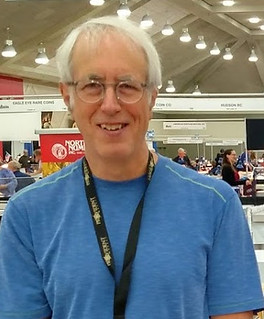 TOM CALDWELL: I would say a couple of things. I would say, go to shows, see
things, see coins, see how things are graded, but most importantly, find a mentor.
Find somebody that you can talk to that will guide you. I mean, most dealers would
be open to that. We've mentored a few kids throughout the years. And I think those
two things really. And of course, nowadays you can look online at coins to get a
sense of how things look and all that. And also, I would say, if they're really
serious, go to the grading seminar at the ANA. Try to get a, have them pay for it,
which they do. Just go. And also, there's Seth Chandler to the coin university out in
San Francisco, who's made some inroads in that department.
TOM CALDWELL: I would say a couple of things. I would say, go to shows, see
things, see coins, see how things are graded, but most importantly, find a mentor.
Find somebody that you can talk to that will guide you. I mean, most dealers would
be open to that. We've mentored a few kids throughout the years. And I think those
two things really. And of course, nowadays you can look online at coins to get a
sense of how things look and all that. And also, I would say, if they're really
serious, go to the grading seminar at the ANA. Try to get a, have them pay for it,
which they do. Just go. And also, there's Seth Chandler to the coin university out in
San Francisco, who's made some inroads in that department.
GREG BENNICK: For sure. He's been great with young numismatists.
TOM CALDWELL: He's paid all the tuition and everything and if they're younger, he's had to pay for the parents to go there. He's had good intentions and that's working out. And along those lines, we have seen, if you had asked me a couple of years ago about new people in the business, I would say it's not really seen. I would never come out and say that the coin business is going down the tubes because there aren't any people. But there's been a lot in the last couple of years that have come out. We've seen at the shows and basically, if the young person has the interest if they're smart, they know what, you can have a coin business online and so we think the future is promising for the coin business with many young people getting involved.
GREG BENNICK: That's great, what about young collectors? Just in case there's young collectors watching this, what advice would you have for people getting started in coin collecting? Not even necessarily young collectors, what if there was a 60-year-old or a 30-year-old didn't necessarily get involved in coins for the first time. What advice would you have for coin collectors?
TOM CALDWELL: Well, I think it would be similar advice to go to a show. Learn about the history of coins and just continue from there. Find an area that you really enjoy. You want to collect a set of Morgan dollars or a type set of U.S. coins or paper money interests you or mint errors or whatever. Just find something that really strikes you and study it. You can't necessarily learn it all unless you're really in it full-time and so forth but find something that's an area that really strikes you.
GREG BENNICK: I think it's important to have that connection to it. And whatever it might be, a different way of thinking about it. Yeah. Draws you to coins. I know that for me, I ended up collecting things that my father had collected, and whatever it might be for folks, I think it's important to have that draw, personal draw to the coins. You're not just doing it by rote per se, but rather have an actual emotional or personal or historical collection to what you're collecting.
TOM CALDWELL: Too many people, it's easy to have a learning curve, which is understandable. It is understandable to have a learning curve. They might come in to see us at some point after they've been collecting for X number of years, and they've got a couple of Buffalo nickels and a few Liberty Standing quarters. And maybe they thought they were being smart, and they could outsmart everyone else online, and they bought a third world grading service coin. And they finally have a focus. So, it's good to have a focus on just what you want to do, not just necessarily be random about what you buy.
 GREG BENNICK: It makes sense. So, a couple more questions for you. What are
your favorite coins that you've handled? What are your favorite coins that you've
handled over the years? As you look back on all the coins that have come through,
and I mean, going to your website is a smorgasbord of coins. I mean, there's
sometimes I click on series that I have no interest in whatsoever, just to see all the
cool coins that are on your website. And what are your favorite coins that you've
handled over the years? I mean, you used the example of the 1943 bronze cent, of
course. Are there others that stand out for you? Coins that have come through your
possession that you've bought and sold that really stand out as favorites?
GREG BENNICK: It makes sense. So, a couple more questions for you. What are
your favorite coins that you've handled? What are your favorite coins that you've
handled over the years? As you look back on all the coins that have come through,
and I mean, going to your website is a smorgasbord of coins. I mean, there's
sometimes I click on series that I have no interest in whatsoever, just to see all the
cool coins that are on your website. And what are your favorite coins that you've
handled over the years? I mean, you used the example of the 1943 bronze cent, of
course. Are there others that stand out for you? Coins that have come through your
possession that you've bought and sold that really stand out as favorites?
TOM CALDWELL: Well, I remember being at a Bowers and Merena sale and buying a, I believe this was right at the start of grading or a little bit before, buying a gem-proof Stella. And the dealer next to me says, is that the first one of those you own? I said, yes. So, then I bought the next one, the next lot. It was the second one I owned. (laughter) That comes to mind. Recently, we've had a couple of Pan Pac $50 gold pieces a round and an octagonal. Those are things that I can think of that is really always fun to own. Those are the type of coins that it's been said that people, once they've been collecting for a while, maybe in the long run, they should just get, let's say ten or let's say twenty different really cool coins they should own. We did a trade recently with a customer that we met in the lobby at Long Beach and he traded about 25 coins, plus a cheque payment for our Pan Pac $50 gold piece that we had. And that was going to be one of his really outstanding pieces that he's going to hold on to for long term. So those are a couple that come to mind.
GREG BENNICK: That's nice. I like that kind of collecting with The Box of 20
idea where you've got a box of twenty coins. That's great. And then...are there any
coins that you wish you handled over the years? Any that either came close and got
away or just ones that you just never had an opportunity to own?
TOM CALDWELL: Well, yeah, I'd say one that comes to mind is the 1913 nickel. I remember back in the 80s, it was me and Larry Whitlow and a couple other dealers. We were trying to form a consortium to buy it if it sold for X amount of dollars. I think it was only about $300,000, $400,000 at the time. And of course, we didn't come close. But that's one that I've always liked. Also, I think an undervalued rarity is a 76-CC twenty cent piece. It's about a million dollar plus coin right now. Always liked that. There was very few known. Those are two that come to mind.
GREG BENNICK: That's great. Well, I like hearing this. Well, I appreciate all the
things that we've talked about so far. We've covered a bit about history. We've
covered a bit about the present and how things have changed over time. Is there
anything else that I've missed in the course of thinking about what to ask you
today? I just want to give you the opportunity to say, You know what, Greg, you
missed this one important story that I wanted to share...
TOM CALDWELL: Well, you probably have, but not that I could think of right off hand. (Laughter) Nothing that comes to mind right now.
GREG BENNICK: Okay, no problem. Well, we can always do a part two at some point, if you like. I certainly am going to be doing some follow-up interviews with some of the folks I've interviewed in the past. Is there a general coin show schedule that you follow? If people want to meet you in person, if they want to talk to you, see the coins that maybe they haven't seen online already, or even if they have, see them again. Is there a general list of coin shows that you always go to?
TOM CALDWELL: Well, we've been for close to about fifty years now, we've been to every Long Beach show. That's three times a year. Although, frankly, it's creeping into our mind to maybe skip one because it's not the prominent show that everybody has to go to like it used to be. There's a couple of regional shows here in Manchester, New Hampshire that Ernie runs. There's the Baltimore show three times a year. Central States in the spring, which is our next major show at this point. Those are the major ones that we go to. And we've had a couple of club shows, like the one, in St. Louis in February, which is a fun show to go to. Probably a couple of those I'm not thinking of, but those are the ones that are kind of ones we always go attend.
GREG BENNICK: Yeah, great. Well, that's a good list. You know, I've always thought about dealers like yourself who go to so many shows. There must be, you know, there has to be a cap or a limit at some point between, or rather not a cap or a limit, but there has to be a figuring out of expenses because it's expensive to fly to shows and what not and insure coins, that sort of thing. There has to be at some point a figuring out, of course, of what shows are the ones that do the best and so that you can actually make up and exceed your expenses with profit. I can only imagine that's a tricky thing.
TOM CALDWELL: And that comes into play all the time. Expenses have gotten more expensive all the time, more expensive to travel. And sometimes we're better off just spending our time in the office. We get a lot of, we're always busier in the office and making efforts to buy back coins from collectors. And so, it's something we're thinking of all the time.
GREG BENNICK: Okay. Well, Tom, thanks so much for spending some time today. You and I can stay online for a few moments after we stop recording here, but I just wanted to say to everybody, if you're interested in Tom and the coins that he has for sale, go to www.northeastcoin.com and check out the entire inventory there. And then in addition, if you'd like to see others of these interviews, be sure to check those out as well and let people know that this is an ongoing series of interviews with numismatists from around the world in all different states of how you'd say with all different states of history, meaning some people who've been involved in the hobby for fifty years, some people who've been involved for less, but all of whom have different areas of expertise that I'm going to be wanting to explore with them. So, thanks so much for watching and Tom, thanks for spending a few minutes today. I really appreciate it.
TOM CALDWELL: It's a pleasure. Keep up the good work.
GREG BENNICK: Thank you.
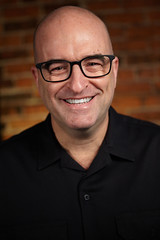 About the Interviewer
About the Interviewer
Greg Bennick (www.gregbennick.com) is a keynote speaker and long time coin collector with a focus on major mint error coins. Have ideas for other interviewees? Contact him anytime on the web or via instagram @minterrors.
To watch the complete video, see:
Tom Caldwell Interview
(https://nnp.wustl.edu/library/book/633370)
To read the complete transcript, see:
Tom Caldwell Interview (Transcript)
(https://nnp.wustl.edu/library/book/633369)
To read the earlier E-Sylum articles, see:
TOM CALDWELL INTERVIEW, PART ONE
(https://www.coinbooks.org/v26/esylum_v26n53a15.html)
TOM CALDWELL INTERVIEW, PART TWO
(https://www.coinbooks.org/v27/esylum_v27n01a16.html)
TOM CALDWELL INTERVIEW, PART THREE
(https://www.coinbooks.org/v27/esylum_v27n02a14.html)
DR. PETER VAN ALFEN TO CHAIR CCAC
The Citizens Coinage Advisory Committee (CCAC) has a new chairperson. Here's the U.S. Mint announcement. -Editor
The United States Mint announced today that the Deputy Secretary of the Treasury has appointed Dr. Peter van Alfen as the next Chairperson of the Citizens Coinage Advisory Committee (CCAC), effective January 30, 2024. By statute, the CCAC Chairperson is appointed from among the current members and serves a one-year term.
 Dr. van Alfen was appointed to the CCAC in 2020 as the member specially qualified in numismatic curation.
Dr. van Alfen was appointed to the CCAC in 2020 as the member specially qualified in numismatic curation.
Dr. van Alfen is Chief Curator at the American Numismatic Society (ANS), where he has served for more than 20 years. Dr. van Alfen was initially hired as curator of ancient Greek coinage, and his curatorial responsibilities were later expanded to include the medallic art section. For more than a decade, Dr. van Alfen has served on the J. Sanford Saltus Award committee, which bestows awards to living artists for achievement in medallic art. In recent years, he has been involved in the creation of several of the ANS's online resources, including the Hellenistic Royal Coinages project funded by the National Endowment for the Humanities, and the Art of Devastation, a site devoted to the medallic art of the First World War.
Dr. van Alfen has been instrumental in leading and developing the ANS's flagship educational program, the Eric P. Newman Summer Graduate Seminar, and has served for 15 years as editor of the ANS's quarterly, ANS Magazine. Dr. van Alfen's publications include more than a dozen books and scores of articles on ancient coinage and monetary systems, as well as on U.S. and European medallic art, particularly in the 19th and 20th centuries. In 2019, Dr. van Alfen received the Burnett Anderson Memorial Award for Excellence in Numismatic Writing.
Dr. van Alfen holds a Ph.D. in Classics from the University of Texas at Austin, an M.A. in Anthropology (Nautical Archaeology) from Texas A&M University, and a B.A. in Classics from the University of Utah. He has participated in several ancient shipwreck excavations and surveys in Turkey and Egypt and continues to be an Affiliated Scholar with the Institute of Nautical Archaeology.
About the CCAC
The CCAC was established by an Act of Congress in 2003. It advises the Secretary of the Treasury on theme or design proposals relating to circulating coinage, bullion coinage, Congressional Gold Medals, and other medals produced by the United States Mint. The CCAC also makes commemorative coin recommendations to the Secretary and advises on the events, persons, or places to be commemorated, as well as on the mintage levels and proposed designs.
The CCAC is subject to the authority of the Secretary of the Treasury. The United States Mint is responsible for providing necessary and appropriate administrative support, technical services, and advice. The CCAC submits an annual report to Congress and the Secretary of the Treasury, describing its activities and providing recommendations.
For more information see:
https://www.ccac.gov/
Peter van Alfen, Ph.D. Qualified in Numismatics
(https://www.ccac.gov/aboutUs/bio_van_alfen_Peter.html)
To read the complete press release, see:
Deputy Secretary of the Treasury Appoints Dr. Peter van Alfen Chairperson of Citizens Coinage Advisory Committee
(https://www.usmint.gov/news/press-releases/deputy-secretary-of-the-treasury-appoints-dr-peter-van-alfen-chairperson-of-citizens-coinage-advisory-committee)
WHY BANKNOTES LOOK AS THEY DO
E-Sylum subscriber Jacques Hymans is an Associate Professor of International Relations at the University of Southern California. He recently published an article in the Brown Journal of World Affairs entitled "It's All About the Benjamins: Why Banknotes Look As They Do, And Why You Should Care." discussing the social and economic importance of the images on banknotes, and trends in the nature of those images over time. Here are a couple excerpts, but the complete article is available free online. Check it out! -Editor
Once upon a time, banknote iconography was a vitally important means of
anti-counterfeiting security. Today, however, note issuers have much more
sophisticated anti-counterfeiting technologies, so banknote iconography is no longer necessary for that purpose. According to neuroscientist David Eagleman, banknotes are jam-packed with decorative features that have nothing to do with security—the trees, the patriots, the birds, the flags, the swirling colors. No one notices the security features because of all the distractions.
Eagleman argues that in order to maximize the efficiency of cash transactions, the ideal banknote would be a blank white piece of paper with a single hologram in the middle.
The fact that no monetary authority has ever followed Eagleman's advice
indicates that banknote iconography is not just for anti-counterfeiting. Eagleman himself suggests as much, lamenting that currencies are supposed to impress the viewer with the regal power and artistic talents of a ruling body. Apparently, no government wants to appear un-regal and un-artistic when compared with another government.
In other words, Eagleman's hypothesis is that political regimes are using banknote iconography to glorify themselves.
Some regimes certainly do treat their banknotes as vehicles for blatant political propaganda. For example, the longtime Haitian dictatorship of François Papa Doc
Duvalier and his son Jean-Claude Baby Doc
Duvalier placed their portraits front and center on various denominations of Haitian gourde banknotes. Both the father and the son actively involved themselves in the design process. For example, having hired the New York-based American Bank Note Company to design a new 10 gourde note in the 1970s, Jean-Claude Duvalier caused production delays with his repeated requests to alter the portrait. Banknote historian Mark Tomasko writes that Duvalier's requests were particularly to make him appear younger and less heavy. The final portrait was very complimentary to
‘Baby Doc'
.
Banknote iconography is intended to be meaningful as well as beautiful.
Ever since the consolidation of the global one nation, one money
norm approximately a century ago, states have especially leveraged banknote iconography to remind consumers of their pride and sense of belonging in the national community. By priming people's collective identity, the iconography both channels and supports the generalized social trust that is crucial for the smooth functioning of the money economy. Supranational monetary authorities can play this game, too. For the 2002 launch of the euro banknotes and coins, the European Central Bank (ECB) explicitly invoked European identity with its official slogan the EURO. OUR money.
To read the complete paper, see:
It's All About the Benjamins: Why Banknotes Look As They Do, and Why You Should Care
(https://bjwa.brown.edu/29-2/its-all-about-the-benjamins-why-banknotes-look-as-they-do-and-why-you-should-care/)
NUMISMAGRAM MEDAL SELECTIONS: JANUARY 21, 2024
Numismagram's Jeremy Bostwick passed along these four medals from his most recent upload of new material to his site. For all of the new items, please visit https://www.numismagram.com/inventory. -Editor
102703 | BOHEMIA. Czechoslovakian Folklore bronze Medal of Merit. Issued 1895 for the exhibition held in Prague, and awarded to the staff of the steward service (55mm, 72.83 g, 12h). By V. Šantrucek & I. B. Pichl. NÁRODOPISNÁ VÝSTAVA CESKOSLOVANSKÁ V PRAZE, female figure in traditional attire kneeling right, removing garment from chest; MDCCCXCV in exergue // Male figure kneeling right, holding linden branch overhead; ZÁSLUZE / O. N. V. C. in two lines to right. Edge: Plain. Hauser 3785. Choice Mint State. Rich red-brown surfaces, with a great glossy nature in the fields and charming relief. $195.
To read the complete item description, see:
102703 | BOHEMIA. Czechoslovakian Folklore bronze Medal of Merit.
(https://www.numismagram.com/product-page/102703)
102660 | SWEDEN & FINLAND. "Only One Earth" multi-piece bronze Medal. Issued 1972 for the United Nations Conference on the Human Environment held in Stockholm (49mm, 227.80 g, 12h). By K. Räsänen for Sporrong. Top piece, obverse: Facing female head, slightly left of center, with hair billowing in the wind (indicative of environmental influences) // Top piece, reverse: ONLY ONE EARTH EN ENDA VÄRLD, nude female (Mother Earth) curled left in fetal position within oval-like shape in relief and with lines of longitude and latitude /// Bottom piece, obverse: Nude female crouching slightly right, protecting her face with her left hand // Bottom piece, reverse: UNITED NATIONS CONFERENCE ON THE HUMAN ENVIRONMENT 5. – 16. 6. 1972, the same nude female from the reverse of the other piece, this time curled right in fetal position within oval-like shape, all in incuse and without the gridlines. Edge: 1747•3500 / SPORRONG. Hackl & Klose 37. As made. Brassy-dark brown surfaces, with great brilliance and a two-toned nature. Includes original box of issue, as well as certificate of authenticity. A very moving and thought-provoking multi-piece medal that was very much the calling-card of Räsänen. $225.
Räsänen's interesting take on the environmental movement came at a time of greater appreciation for the frailty of the Earth and the irreparable damage which man can and has created. This multi-piece medal was made in conjunction with the conference held by the United Nations in 1972, even featuring their logo upon it.
To read the complete item description, see:
102660 | SWEDEN & FINLAND. "Only One Earth" multi-piece bronze Medal.
(https://www.numismagram.com/product-page/102660)
102659 | SWEDEN. Göteborg Numismatic Association bronze Medal. Issued 1973. Commemorating the 40th anniversary of the association (55mm, 100.11 g, 12h). By G. Svensson-Lundkvist at the Royal Swedish mint. Oversized klippe issue in high relief surrounded by numerous other coins in stacks; issues represented include Greek and Roman ancients, some medieval hammered, and modern machine struck coinage // GÖTEBORGS NUMISMATISKA FÖRENING 1943–1973, two ships approaching the docks; seagulls flying in the foreground above two fish; various modern Swedish coins around to left. Edge: MV BRONS 1973. Gem Mint State. Alluring olive-brown surfaces, with great intricacy and depth. $195.
Featuring a wide variety of coinage from ancient to modern, this ambitious design presents great detail and allows the most advanced numismatist a chance to determine as many discernable types as possible.
To read the complete item description, see:
102659 | SWEDEN. Göteborg Numismatic Association bronze Medal.
(https://www.numismagram.com/product-page/102659)
102588 | GREAT BRITAIN & SWEDEN. Björn Borg pentagonal enameled cast bronze Medal. Issued 1981. Commemorating his five consecutive Wimbledon men's championships (81mm x 77mm, 150.20 g, 12h). By F. Rich. Head left, wearing headband; all over BJORN / BORG in two lines in background; around, headshots of Borg celebrating with his trophy for each of five different years // FIVE CONSECUTIVE YEARS MENS SINGLES CHAMPION / WIMBLEDON 1976–1980, bird's-eye view of Centre Court, with various spectators (some of whom hold parasols) looking upon the court, which is enameled brightly in green. Edge: Plain. "The Medal" 2 (1982), p. 8; "De Beeldenaar" –; "Svensk Numismatisk Tidskrift" –. Essentially as made. Deeper brown recesses, with lighter hues upon the higher points; full enameling on the tennis court. Great relief between the convex and concave nature. Incredibly rare, with an unknown, but almost certainly miniscule, number of examples produced. Seemingly unpublished save for its brief mention in the second issue of "The Medal". $1,495.
Before the likes of Sampras, Federer, Nadal, and Djokovic would come to dominate men's tennis, Björn Borg left an awe-inspiring impression upon a sport that had not seen anything like it. Not only did he win six titles at Roland Garros (the French Open), four of which were consecutive, he won five consecutive titles at Wimbledon, taking it each year from 1976 through 1980. Though retiring rather shockingly at the age of just 25, he amassed an incredible winning resumé in a brief career. In Mark Jones's article in issue 2 of "The Medal," he mentions this design as making an appearance at the Royal Academy Summer Exhibition in 1982, writing that "Fred Rich's 'Bjorn Borg', which won the Royal Society of Arts medal bursary in 1981 was, unfortunately, shown with the less impressive, portrait side up–concealing the highly original reverse, with its bird's eye view of the Centre Court, surrounded by a forest of intent heads and highlighted by silver inlaid in bronze." Despite Jones's take on this medal's obverse, its intriguing and highly interesting nature, both obverse and reverse, cannot be understated. Only its sheer rarity can rival its enigmatic design, as this cataloger has been unable to trace any other mentions of the type, for sale in the past or otherwise.
To read the complete item description, see:
102588 | GREAT BRITAIN & SWEDEN. Björn Borg pentagonal enameled bronze Medal.
(https://www.numismagram.com/product-page/102588)
LII COLLECTION OF HISTORICAL COINS AND MEDALS
Heritage is offering an important collection of coins and medals in their January 22, 2024 sale. Here are some selections. -Editor
The LII Collection of Historical Coins & Medals Auction
On Monday, January 22, 2024, Heritage Auctions will offer The LII Collection of
Historical Coins and Medals in an unreserved Showcase Sale. The 100 lots cataloged will
be a fleeting moment compared to its 2,500 year span of history portrayed within. From
Ancient Athens to Modern Tunisia, there are items to interest neophytes to advanced
specialists. Significant pedigrees abound and often complement the historical events
exemplified upon them. Many of these pieces are rarely seen except in named public
sales or museums. Often, they are only obtainable generationally – if at all. Riveting
imagery, superior condition, and attractive patinas broadly brush a sweeping canvas of
numismatic iconography from A
to Zebra.
There should be something for all
collecting tastes and budgets.
Lot 24039
Germany-Saxony. Friedrich August I silver "Campaign Against the Turks in Hungary"
Medal 1695-Dated MS63 NGC,
cf. Merseburger-1359 (there in bronze), Engelhardt-1204.
32mm. Plain edge. By Wermuth.
Enigmatic and rarely encountered. This Clain-Stefanelli pedigreed piece is one of a
triptych of Ottoman related historical medals offered. The lightning striking the dragon
emits a stark image upon the reverse that is thought provoking.
To read the complete lot description, see:
German States: Saxony. Friedrich August I silver "Campaign Against the Turks in Hungary" Medal 1695-Dated MS63 NGC,
(https://coins.ha.com/itm/german-states/saxony/german-states-saxony-friedrich-august-i-silver-campaign-against-the-turks-in-hungary-medal-1695-dated-ms63-ngc-/a/61359-24039.s)
Lot 24045
Great Britain. Henry VIII (1509-1547) Testoon ND (1544-1547) VF Details (Test Cut)
NGC,
Tower mint, Pellet in annulet mm, Third coinage, S-2365, N-1841.
One of several historic Tudor period coins cataloged in this gathering. The debasement of
Henry's coinage was rampant when this larger Testoon denomination was created near
his death in 1547. Often poorly made from the start, this round and broad example is
struck on good metal, strongly detailed, and superior to the majority extant.
To read the complete lot description, see:
Great Britain: Henry VIII (1509-1547) Testoon ND (1544-1547) VF Details (Test Cut) NGC,...
(https://coins.ha.com/itm/great-britain/great-britain-henry-viii-1509-1547-testoon-nd-1544-1547-vf-details-test-cut-ngc-/a/61359-24045.s)
Lot 24057
Great Britain. "James II and the Seven Bishops" silver Medal ND (1688) MS61 NGC,
MI-
634-57, Hawkins-pg. 634, 57. 48mm.
Archbishop Sancroft and the seven Bishops imprisonment by James II not only influenced
Continental and English medalists, but furthered ushering in the accession of the House of
Orange to the English Throne. The Owl
lacks the fame of many great Anglo-Dutch medals
due its immense rarity. This former Clain-Stefanelli prize was pursued ravenously when first
auctioned a decade ago. Most examples known reside in museums and this is stellar
preservation.
To read the complete lot description, see:
Great Britain: "James II and the Seven Bishops" silver Medal ND (1688) MS61 NGC,...
(https://coins.ha.com/itm/great-britain/great-britain-james-ii-and-the-seven-bishops-silver-medal-nd-1688-ms61-ngc-/a/61359-24057.s)
Lot 24062
Great Britain. George I silver "Accession" Medal 1714 MS62 NGC,
Eimer-464, MI-421/4.
44mm. Plain edge. By G.W. Vestner (Unsigned).
This 1714 Hanoverian dynastic accession medal is captivating with its leonine
astrological reverse and elaborately detailed. It was in the same collection for 86 years
when last auctioned at Dix Noonan Webb (Noonan's) in December 2020 for nearly
$7,500 U.S.
To read the complete lot description, see:
Great Britain: George I silver "Accession" Medal 1714 MS62 NGC,...
(https://coins.ha.com/itm/great-britain/great-britain-george-i-silver-accession-medal-1714-ms62-ngc-/a/61359-24062.s)
Lot 24077
[Great Britain]. Hyman Montagu Collection Series (1895-1897; 1890) Specially Deluxe
Bound Two Volumes Set,
Sotheby, Wilkinson & Hodge. The epic Montagu English sales in
multiple parts over three years in addition to the earlier 1890 Spink sale of patterns and
proofs bound together in two volumes by Spink & Son. This set, though worn, was used for
decades in the Stack's Family Library by such luminaries as the Clain-Stefanelli's, Jim Risk,
Bob Archer, and John Burnham. Each, Crown quarto (24.5cm by 19.5cm).
Both in the original matching red half morocco, pebbled crimson cloth sides, five raised bands, spine compartments either paneled or lettered in gilt, marbled end-sheets and page edges. One of the most important pedigree works for the English series and a numismatic literature masterwork.
To read the complete lot description, see:
Great Britain: Hyman Montagu Collection Series (1895-1897; 1890) Specially Deluxe Bound Two Volumes Set,
(https://coins.ha.com/itm/great-britain/great-britain-hyman-montagu-collection-series-1895-1897-1890-specially-deluxe-bound-two-volumes-set-total-2-/a/61359-24077.s)
Lot 24082
Papal States. Pius V silver "Battle of Lepanto" Medal Anno VI / 1571 MS63 NGC,
cf. Modesti-614 (there in bronze). 37mm. Plain edge. By G. Bonzagni (Parmensis).
Another important Ottoman historical related medal. The epic naval battle was one of last fought from galleys (like in Ben-Hur) and the Papal backed naval victory was critical.
This silver striking is an original dies example that came from the Stefanelli Collection and is virtually Gem.
To read the complete lot description, see:
Italy: Papal States. Pius V silver "Battle of Lepanto" Medal Anno VI / 1571 MS63 NGC,...
(https://coins.ha.com/itm/italy/papal-states/italy-papal-states-pius-v-silver-battle-of-lepanto-medal-anno-vi-1571-ms63-ngc-/a/61359-24082.s)
Lot 24088
"Capture of St. Eustatia" silver Medal 1781-Dated MS 62 Prooflike NGC,
Van
Loon-556. 45mm. By Holtzhey.
The collection contains several popular Betts listed examples from the John Law and Anglo-Dutch series. This has a striking cameo effect to its nearly full-facing portraiture.
To read the complete lot description, see:
Netherlands: "Capture of St. Eustatia" silver Medal 1781-Dated MS 62 Prooflike NGC,...
(https://coins.ha.com/itm/netherlands/netherlands-capture-of-st-eustatia-silver-medal-1781-dated-ms-62-prooflike-ngc-/a/61359-24088.s)
This enticing collection will be auctioned on Monday, January 22, 2024, starting at 1:00 PM Central Time (2:00 P.M. Eastern, 7:00 P.M. GMT) on HA.com. Please contact Client Services at 214-409-1150 for further information or the World Coin department.. All lots are currently online to view and open for bidding now at ha.com/61359.
THE BOOK BAZARRE
NOONAN'S OFFERS SCOTTISH COIN COLLECTION
Noonan's of Mayfair will be offering a large collection of Scottish coins in their January 24, 2024 sale. Here's the announcement. -Editor
The first part of a large collection of Scottish coins dating from the period of William the Lion through to James V (c. 1180-1540) and amassed over the last 50 years will be offered at Noonans Mayfair in a single-owner sale titled A Collection of Scottish Coins, the Property of a Gentleman (Part I) on Wednesday, January 24, 2024 at 10am. The first sale will comprise 180 lots and is estimated at £60,000-80,000.
The collector, who wishes to remain anonymous concentrated on collecting silver coins (first pennies or sterlings, then in later reigns buying predominantly groats). It is a very commercial selection and with interest in Scottish coins still very strong, Noonans anticipate keen competition from dealers and collectors alike, both at home and abroad.
Highlights include an excessively rare and important sterling from the first coinage of Alexander III (1249-1286) from the Kinghorn mint in Fife, estimated at £1,200-1,500 [lot 13]. This is the place where Alexander is known to have died in a riding accident on a stormy night in March 1286.
Elsewhere in the group, there is a rare and superb Robert the Bruce silver penny from the mint of Berwick. This is estimated at £1,200-1,500 [lot 53]. As Jim Brown, Coin Specialist, Noonans commented: A giant in Scottish history, in his reign Robert the Bruce fought tirelessly to reinstate Scotland as an independent country, culminating in the defeat of the English under Edward II at the Battle of Bannockburn in 1314 where the Scots were outnumbered three to one.
From the reign of Robert the Bruce's successor, David II (1329-1371) is a rare First issue Halfpenny expected to fetch between £1,200-1,500 [lot 54].
A very rare groat of Robert II (1371-1390) from the Dundee mint – which only operated for a short time - is estimated at £1,000-1,200 [lot 100], while from the reign of James I (1406-1437) a First Fleur-de-lis issue Groat from the Edinburgh mint decorated with saltires, and the only specimen struck from this die-pairing, is estimated at £400-500 [lot 134].
An extremely rare second issue groat dating from the 1450s during the reign of James II (1437-1460) and from the Edinburgh mint is estimated at £1,000-1,200 [lot 140]. Also from Edinburgh is a very rare groat from the reign of James III (1460-1488) dating from 1471-83, with distinctive large thistle-head decorations on the reverse. This carries an estimate of £1,200-1,500 [lot 145].
From the following reign, an example of a rare light coinage groat of James IV (1488-1513) produced at the Edinburgh mint is estimated at £1,200-1,500 [lot 152]. As Mr Brown commented: Scottish Parliament records show that a new coinage was being ordered in June 1496, suggesting this may well be the date for the introduction of the light coinage.
One of the later coins in the collection is a groat from the reign of James V (1513-1542) from the Holyrood Abbey mint which carries an estimate of £1,200-1,500 [lot 153]. Mr Brown finished by saying: The portrait used in the early stages of the groat coinage is notable in that it can bear no possible resemblance to the King himself, who was only 14 years old at the time!
For more information, see:
https://www.noonans.co.uk/
STACK'S BOWERS TO SELL JOHNSON COLLECTION
The collection of the late D. Wayne Johnson will be offered for sale this year. Here's a short announcement from Stack's Bowers Galleries. -Editor
Stack's Bowers Galleries is honored to be offering the D. Wayne Johnson (better known as Dick Johnson) Collection of art medals, coins, non-art medals, tokens, numismatic art, and assorted exonumia in a series of sales in 2024. Dick was a talented cataloger and numismatic historian who was a fixture in the world of art medals and the broader numismatic community for well over half a century. In addition, Dick cofounded the Rittenhouse Society in 1957 (a club of eminent numismatists that continues today) and was a founding editor of Coin World.
The first event will feature material produced by Tiffany & Co. to be held in April. Future sales will include material produced by the Medallic Art Company (a firm to which Johnson dedicated a good portion of his professional life), the U.S. Mint, and a range of other mints in the United States and around the world. The material offered reflects the breadth of Johnson's interests and professional experience. Stay tuned for more auction information!
Dick was also a longtime booster and contributor to The E-Sylum. We'll look forward to the sales! -Editor
To read the complete article, see:
THE D. WAYNE JOHNSON COLLECTION COMES TO MARKET IN 2024
(https://stacksbowers.com/the-d-wayne-johnson-collection-comes-to-market-in-2024/)
To read earlier E-Sylum articles, see:
D. WAYNE JOHNSON (1930-2020)
(https://www.coinbooks.org/v24/esylum_v24n01a06.html)
RECOLLECTIONS OF D. WAYNE JOHNSON
(https://www.coinbooks.org/v24/esylum_v24n01a18.html)
A DICK JOHNSON E-SYLUM SAMPLER
(https://www.coinbooks.org/v24/esylum_v24n01a19.html)
MORE ON D. WAYNE JOHNSON
(https://www.coinbooks.org/v24/esylum_v24n02a15.html)
NUMISMATIC NUGGETS: JANUARY 21, 2024
Here's a selection of interesting or unusual items I came across in the marketplace this week. Tell us what you think of some of these. -Editor
1729 Bavaria Charles Albert Double Karolin
Bavaria.
Charles Albert, 1726-1745.
Double Karolin 1729, Munich.
Very rare. NGC MS63. Extremely fine to FDC.
From the Künker Auction 100. -Editor
To read the complete lot description, see:
Karl Albert, 1726-1745. Doppelter Karolin 1729, München. 19.40 g. Fb
(https://www.kuenker.de/en/auktionen/stueck/379895)
Paul Niclausee Grandmother with Infant Medal
This beautiful cast bronze sculpture by Paul Niclausee depicts a loving grandmother holding an infant in her arms.
From the eBay listings of Hedley Betts. -Editor
To read the complete lot description, see:
France GRAMDMOTHER WITH AN INFANT by Paul Niclausee cast bronze 105mm x 112mm
(https://www.ebay.com/itm/166548589623)
1918 Pittsburgh Field Club Golf Medal
JOCK HUTCHISON'S 1918 PITTSBURGH FIELD CLUB RED CROSS 10K GOLD WINNERS MEDAL
This historic and beautiful 10k gold winner's medal features a deep red enamel Red Cross in the center, with 'Pittsburgh Field Club Patriotic Tournament' encircling it and laurels acting as the outer layer. The medal has great appeal, including elegant engraving on the back of ‘Presented to Jack Hutchison' (his formal name) followed by the date ‘July 13th, 1918.' Gold precious metal stamping ‘10k' can be found below the inscription. The Pittsburgh Field Club, an Alexander H. Findlay design, is a renowned Pennsylvania course having hosted the 1937 PGA Championship, the qualifying rounds for the 1953 U.S. Open and the 1959 Western Open.
This 1918 Red Cross Patriotic Tournament featured Jock Hutchison teaming with Walter Hagen in front of a record 2,500 patrons. Hutchison and Hagen defeated reigning U.S. Amateur and Open Champion, Chick Evans, and his partner Warren Wood, former Western Open Champion, 3 and 2 in match play. This war time effort raised over $10,000 for the Red Cross - the largest amount ever raised to that point.
Jock, then connected to Glenview Country Club, of Chicago, and formerly of Allegheny Country Club, of Pittsburgh, would later win two major championships, the PGA Championship in 1920 and the Open Championship at St Andrews in 1921. He also became the first honorary starter at the Masters with Fred McLeod in 1963. He was later inducted into the World Golf Hall of Fame. The medal measures 1 1/2" in diamete
I'm no golfer, but the connection to my hometown Pittsburgh made this one stand out. -Editor
To read the complete lot description, see:
JOCK HUTCHISON'S 1918 PITTSBURGH FIELD CLUB RED CROSS 10K GOLD WINNERS MEDAL
(https://thegolfauction.com/Jock_Hutchison_s_1918_Pittsburgh_Field_Club_Red_Cr-LOT137059.aspx)
A similar medal brought over $8,000 in a 2014 Heritage sale. -Editor
To read the complete lot description, see:
1918 Walter Hagen Gold Medal From Red Cross Exhibition....
(https://sports.ha.com/itm/golf-collectibles/miscellaneous/1918-walter-hagen-gold-medal-from-red-cross-exhibition/a/7110-80398.s)
2024 Taiwan Year of the Dragon $10
Taiwan has released their 2024-dated silver Proof and base metal collector coins in celebration of the Year of the Dragon. The coins are part of the third Lunar Zodiac
series which commenced in 2017. The zodiac cycle renews itself every 12 years and, as such, the third series will conclude with the 2028 release. As this is the year which is represented by the only mythical and the most powerful creature of the 12-animal lunar zodiac, the Year of the Dragon is considered special.
I like this one - a nice balanced design. -Editor
To read the complete article, see:
Taiwan: Latest Lunar Zodiac
silver Proof collector coins feature Year of the Dragon
(https://news.coinupdate.com/taiwan-latest-lunar-zodiac-silver-proof-collector-coins-feature-year-of-the-dragon/)
1966 Royal Bank of Scotland £100
Royal Bank of Scotland, £100, Edinburgh, 3rd February 1966, serial number G 1/5, the first recorded serial number is G 1/1, making this note one of the first printed. This note also has a lower serial number than the plate note appearing in Paper Money of Scotland Volume II, 1st Edition, which has the serial number G 1/6
(PMS RB 62f), about extremely fine, very low serial number
A nice high denomination note. From the SPINK World Banknotes e-Auction. -Editor
To read the complete lot description, see:
ROYAL BANK OF SCOTLAND, £100, EDINBURGH, 3RD FEBRUARY 1966, SERIAL NUMBER G 1/5, (PMS RB 62F),
(https://live.spink.com/lots/view/4-CI6726/royal-bank-of-scotland-100-edinburgh-3rd-february-1966-serial-number-g-15-pms-rb-62f-)
WAYNE'S NUMISMATIC DIARY JANUARY 21, 2024
A snowstorm arrived in Northern Virginia on Tuesday, January 16, 2024, giving me a snow day off work. But by dinnertime most roads and parking lots were cleared and I headed to Not Your Average Joe's restaurant in Reston for the dinner meeting of my numismatic social group, Nummis Nova. Lorne Lavertu was our host.
Before I could even sit down I was having a great conversation with Jon Radel and Roger Burdette about Roger's current work with handwriting recognition. For years now Roger has been diligently mining U.S. Mint records at the National Archives and digitizing them for the Newman Numismatic Portal. Most of these old record books, documents and correspondence were created before the invention and adoption of the typewriter, and thus are handwritten. While the neat script of trained office clerks is generally human readable, machines can have a tough time making it out. Then there is the scrawl of Mint officials' signatures. But combining newer machine techniques with his years of experience, Roger is making great strides. With accurate machine-generated transcriptions of old handwritten documents, researchers will have a much easier time locating and using records relevant to their work. It's becoming a great time to be a numismatic author and researcher.
Other attendees included Mike Packard, Chris Neuzil, Wayne Herndon, new member Mike Markowitz and my guest Kellen Hoard, back in town for a new semester at George Washington University.
I bought along a couple new books acquired since our last regular meeting in November - the new edition of Doug Winter's Gold Coins of the Dahlonega Mint, 1838-1861 and the new Whitman autobiography by Ken Rendell, Safeguarding History: Trailblazing Adventures Inside the Worlds of Collecting and Forging History.
I wish I could say I had a photo of the group, but I got involved with the conversation and dinner and didn't pull out my phone. I sat next to Mike Markowitz and he showed us the manuscript for an upcoming article for CoinWeek on coins of the Gallic Emperors.
Mike writes:
"For fourteen years during the late third century (260 - 274 CE), the western
provinces of the Roman Empire maintained a separate state independent of Rome.
Rulers of this so-called Gallic Empire
issued coinage that was often of better
metal and workmanship than Rome was producing."
Mike was also awaiting a new acquisition which hadn't arrived in time for our meeting.
A Rare Ancient Denomination
Mike Markowitz writes:
"Here is the coin I got in the Triton XXVII sale, which arrived on Thursday. This denomination, which only lasted about 70 years, is so obscure that many collectors have never heard of it."
Lot 914. Constans. AD 337-350. AV Nine Siliquae – 1 1/2 Scripulum (15mm, 1.68 g, 12h). Aquileia mint. Struck AD 340-350. CONSTANS AVGVSTVS, laurel-and-rosette diademed, draped, and cuirassed bust right / FELICI TA S PERPETVA, Victory advancing left, holding wreath in right hand and palm frond in left; SMAQ. RIC VIII –; Depeyrot –; Biaggi –; Triton XXV, lot 1006 (same rev. die). Toned, minor scratches and marks, light deposits. Near EF. Extremely rare. The second known.
Mike adds:
"The gold 1 1/2 Scripulum - 9 Siliquae denomination was introduced by Constantine I circa AD 310, and tariffed at the inconvenient ratio of three-eighths of a gold solidus. It was later replaced by the more convenient gold tremissis under Theodosius I circa AD 383. The denomination is particularly rare as an issue of Constans.
"Surviving sources, possibly influenced by the propaganda of Magnentius's faction, accuse Constans of misrule and of homosexuality. The Roman historian Eutropius says Constans "indulged in great vices," in reference to his homosexuality, and Aurelius Victor stated that Constans had a reputation for scandalous behaviour with "handsome barbarian hostages." Nevertheless, Constans did sponsor a decree alongside Constantius II that ruled that "unnatural" sex should be punished meticulously. However, according to John Boswell, it was likely that Constans promulgated the legislation under pressure from Christian leaders, in an attempt to placate public outrage at his own perceived indecencies."
Et tu Brute?
Chris Neuzil reminded me that
Mike Markowitz brought coins of each of the "12 Caesars" which started a discussion about which 12 they were, because there were actually more than 12 - also a discussion of Caesar assassins.
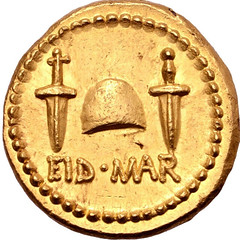 In a post-meeting follow-up, Roger wrote:
In a post-meeting follow-up, Roger wrote:
"For those anxiously awaiting resolution to the "2 Caesar assassins named Brutus" question, here's my reply:
"Marcus Junius Brutus (the famous one and issuer of EID MAR coins)
"Decimus Junius Brutus Albinus (General, friend, and consistent supporter of Iulius Caesar until the dictatorship. This is the Brutus to whom Caesar directed his supposed dying remark Et tu.
)"
One conversation topic at my end of the table was found money - people reported discovering everything from single dollar bills on the ground to envelopes with cash. My biggest haul over the years was about $27 in assorted bills. Chris Neuzil won bragging rights for his find of three hundred-dollar bills at one spot.
The food and drink were good and the restaurant was surprisingly busy for a cold and snowy Tuesday night. On my way home I dropped Kellen off at the nearby Reston Metro station. It was a night with a smaller than usual crowd, but enjoyable nonetheless. Here's hoping for better weather in February.
To read the earlier E-Sylum articles, see:
NEW BOOK: DAHLONEGA MINT GOLD, 4TH EDITION
(https://www.coinbooks.org/v26/esylum_v26n44a03.html)
NEW BOOK: SAFEGUARDING HISTORY
(https://www.coinbooks.org/v26/esylum_v26n31a06.html)
7TH CENTURY BC COIN-WEIGHT FOUND
Aaron Oppenheim passed along this article about a recently discovered 7th century BC coin-weight. Thanks. -Editor
 Israel Antiquities Authority (IAA) Wednesday morning announced the discovery of a rare silver coin, roughly 2,500-years-old, which was found in the Judean Hill and considered one of the earliest evidences in Israel of the social transition to the use of coins.
Israel Antiquities Authority (IAA) Wednesday morning announced the discovery of a rare silver coin, roughly 2,500-years-old, which was found in the Judean Hill and considered one of the earliest evidences in Israel of the social transition to the use of coins.
In addition, the excavations also uncovered a building dating to the Kingdom of Judah period, in the 7th century BCE (2,700 years ago). Inside was a dome-shaped stone weight engraved to represent its value as one shekel.
Through a tiny object like a coin, it becomes possible to trace human thought processes and observe that our economic habits have remained largely unchanged for thousands of years - only the technology has changed,
IAA Director, Eli Escusido, said in a press release statement.
Dated to the Persian period between the 6th and 5th centuries BCE, the coin was found in an intentionally broken state. The less-sophisticated minting process used a sunken
stamp rather than the later technique which would leave a protruding imprint.
"The coin is extremely rare, joining only half a dozen coins of its type that have been found in archaeological excavations in the country" IAA Numismatic Department head, Dr. Robert Kool, said in the statement.
"The coin was minted in a period when the use of coins had just begun. The rare find contributes information concerning the way trade was carried out, and the process whereby global commerce moved from payment by weighing silver pieces, to the use of coins, he explained.
To read the complete article, see:
Archeologists unearth 'extremely rare' intentionally broken 2,500 year-old silver coin
(https://www.i24news.tv/en/news/israel/archeology/1705487545-archeologists-unearth-extremely-rare-intentionally-broken-2-500-year-old-silver-coin)
See also:
Extremely rare 2,550-year-old silver coin unearthed in Judean Hills
(https://www.timesofisrael.com/extremely-rare-2550-year-old-silver-coin-unearthed-in-judean-hills/)
FRANCE MELTS NEW EU COINS
Politico reported this week that the Paris Mint (Monnaie de Paris) was forced to destroy new euro coins due to a design snafu. Here's an excerpt - see the complete article online. Thanks to David Pickup for passing this along. -Editor
 France has destroyed and reminted 27 million coins after failing to ask the EU for design approval and then being told they didn't conform.
France has destroyed and reminted 27 million coins after failing to ask the EU for design approval and then being told they didn't conform.
The Monnaie de Paris, the country's mint, produced the 10, 20 and 50 cent coins with a new pattern in November but later discovered that the way the stars of the EU flag had been depicted was not compliant with the European Commission's very precise requirements.
Under EU law, countries can change the design of the "national" face of euro coins every 15 years, but they need the green light from the Commission as well as other eurozone governments, which have to be informed and have seven days to raise objections.
France informally contacted the Commission in November, before addressing a formal request to approve the design, but the mint had gone ahead without waiting for the EU's OK. It then received an informal warning from the Commission stressing that the new design was not in line with EU rules, according to a French economy ministry official with direct knowledge of the file, speaking to POLITICO on condition of anonymity.
The design of the new coins proposed by the French government and validated by the Commission is still a secret and will be unveiled before the spring, the French economy ministry said.
The Monnaie de Paris did not respond to a request for comment.
But were any examples saved for national numismatic collections? Are there at least photographs? Did any of these coins get spirited away from the melt by workers? I guess we'll know if any of these turn up in the market in the future.
See Roger Burdette's article in this week's Loose Change section for a story of another great coin melt - the conversion of millions of U.S. gold coins into bars after 1933. -Editor
To read the complete article, see:
France melts down millions of coins because EU says its stars don't look right
(https://www.politico.eu/article/france-euro-coins-destroyed-brussels-veto-on-new-design/)
SCIENCE BEHIND FRANKLIN'S MONEY PRINTING
Len Augsburger passed along this American Philosophical Society video of a talk on research into Ben Franklin's anti-counterfeiting techniques. Thanks. He adds, "The early paper money part starts at 19:40 following (non-related) opening remarks from APS personnel." -Editor
Bucking the Counterfeiters: The Science Behind Franklin's Money Printing
Paper money in colonial America relied on the skill of its printers and reputation of its creditors for its value. Benjamin Franklin fought against money counterfeiting in pre-Federal America by inventing new printing methods and production measures. Khachatur Manukyan and his team at the Nuclear Science Laboratory in the Department of Physics and Astronomy at the University of Notre Dame have conducted a comprehensive scientific analysis of 600 paper money notes printed from 1709 to 1790 provide a unique perspective into Franklin's ingenious ways for safeguarding bills, their materials, and historical instances of money manufacturing.
Dr. Manukyan will join us on Franklin's 318th birthday to discuss the methods his team used to analyze pre-Federal American paper money from the Rare Books and Special Collections of the Hesburgh Library at the University of Notre Dame. Their investigation of the chemical compositions of the paper fibers, the inks, and fillers made of special crystals in the bills revealed previously unknown ways that Franklin developed to safeguard printed money notes against counterfeiting. Franklin used natural graphite pigments to print money and developed durable money paper
with colored fibers and translucent muscovite fillers, along with his own unique designs of nature-printed
patterns and paper watermarks.
Khachatur Manukyan is a Research Associate Professor at the Nuclear Science Laboratory in the Department of Physics and Astronomy at the University of Notre Dame. He obtained his Ph.D. in Physical Chemistry from Yerevan State University in Armenia in 2006. Following his doctorate, he held positions at Yerevan State University, the Institute of Chemical Physics at the National Academy of Sciences of Armenia, and the Swiss Federal Laboratories for Materials Science and Technology in Dübendorf. In 2010, Manukyan was awarded a Fulbright Visiting Scholar position at the Department of Chemical and Biomolecular Engineering at the University of Notre Dame. By 2013, he had become a research associate in the Department of Physics and later transitioned to the role of Research Assistant Professor.
Manukyan's research focuses on unraveling the complexities of novel material creation, where the domains of material science, chemistry, and physics overlap. He is fascinated by the rapid physical and chemical processes that lead to significant structural changes, such as rapid phase transitions, amorphization, and crystallization. Apart from contemporary materials, Manukyan is also interested in the structure, composition, and preparation methods of ancient artifacts, such as artworks, medieval manuscripts, historical documents, and even paper money. Through these ancient artifacts, he aims to establish a deep connection with our ancestors, shedding light on the materials they skillfully used and the techniques they mastered. In doing so, he creates a juncture where history and science meet.
To watch the video, see:
Bucking the Counterfeiters: The Science Behind Franklin's Money Printing
(https://boxcast.tv/view/bucking-the-counterfeiters-the-science-behind-franklins-money-printing-pmbbtubya83jsztlotwt?)
STRAWBERRY SCRIP
An article by Stack's Bowers Currency Auction Associate Bradley C. Trotter highlights an interesting scrip note payable in strawberries. -Editor
To many collectors, terms like Silver Certificate and Gold Certificate are instantly recognizable and conjure an array of iconic notes each bearing a range of denominations and vignettes.
However, prior to the emergence and nationwide acceptance of federal currency, a variety of local and state issues filled the void. Known to collectors today as Obsolete Bank Notes, these came in a variety of denominations and bore a cacophony of vignettes that were often tied to local industry.
A merchant operating out of Utica in upstate New York issued a note dated 1862 which bore the vignette of a plump red strawberry. Although unusual in the sense that it depicted fruit as opposed to an allegorical figure or a prominent personality from American history, the guarantee that backed this note also stands apart as an oddity. In an era where notes were often backed with real estate or agricultural cash-crops (such as cotton in the Antebellum South), this note was backed by a quart of strawberries and, if the strawberry crop failed, exchangeable in current banknotes at the Savings Bank, 167 Genesee Street, Utica.
Offered as lot 92052 in our January Collectors Choice Online Auction, this note has been encapsulated by PMG and has been assigned a grade of Very Fine 20 with a comment for a Minor Repair
– done presumably to rectify a small imperfection along the bottom margin.
This is indeed a rare item, one that reflects both the hyper-local reality of currency in the years preceding the American Civil War and the wartime economic realities of the conflict which resulted in a multitude of private issues temporarily filling the void.
The note makes interesting reading. Civil War scrip notes were a collecting specialty of mine for several years. While most are payable in U.S. or Confederate banknotes, many are payable in merchandise such as this. -Editor
To read the complete lot description, see:
Utica, New York. Strawberry Grounds of T. Buchanan, Jr. 1862 10 Cents. PMG Very Fine 20.
(https://auctions.stacksbowers.com/lots/view/3-17O9T2/utica-new-york-strawberry-grounds-of-t-buchanan-jr-1862-10-cents-pmg-very-fine-20)
To read the complete article, see:
HAVE YOU EVER SEEN A STRAWBERRY CERTIFICATE
?
(https://stacksbowers.com/have-you-ever-seen-a-strawberry-certificate/)
LOOSE CHANGE: JANUARY 21, 2024
Here are some additional items in the media this week that may be of interest. -Editor
A Numismatic News article by Patrick Heller discusses how people come to the hobby today. Here's an excerpt - see the complete article online. -Editor
Back in the 1960s, it was easy to become a young coin collector. You could start by sorting through your pocket change to fill in the holes in the inexpensive blue folders. There were also a number of newspaper carriers who became collectors then (and later several of them became dealers) because they collected the subscription money from the customers on their routes. Coin clubs galore sprang up across America from the 1950s through the 1960s.
The reasons that children today become numismatists are different from those in the 1960s. Fewer than 10% of today's transactions in everyday commerce in America are settled with the use of coins or currency. Further, today's coinage no longer has a metal value close to the face value of the coins.
The company where I work has several teenage- and under-thirty employees. Primarily, they became coin collectors because they appreciate history—and coins are a tangible way they can hold history in their hands. A couple just like looking at all the different coin designs, shapes, and metal contents. Even though these younger collectors may not constantly carry loose change in their pockets, they have still found their way to numismatics.

The generational shift in the hobby has been clearly evident for some time. I was one of those newspaper boys collecting subscription payments door to door beginning around 1969. I received silver and foreign coins regularly, and having already started Whitman albums, I eagerly looked for dates and mintmarks I needed. Those days are long gone, but the coins still exist even if they aren't seen in circulation. It's very heartening to see the influx of today's young collectors and dealers.
I'd like to hear from some of our younger readers - how did YOU get started in numismatics? -Editor
To read the complete article, see:
Young Collectors: 1960s Versus Today
(https://www.numismaticnews.net/collecting-101/young-collectors-1960s-versus-today)
Roger Burdette published a CoinWeek article detailing the melting of gold coins into bars after President Roosevelt's 1933 Executive Order. The horror! Painful history for numismatists and collectors. Here's an excerpt - see the complete article online. -Editor
 How did the conversion of millions of coins into 0.900 fine gold bars take place?
How did the conversion of millions of coins into 0.900 fine gold bars take place?
The primary consideration was security. Not merely the usual protection of gold from loss or theft but also the influence of international politics on America's national security.
To safeguard America's gold, Treasury Secretary Henry Morgenthau's staff developed a three-step plan. The first step was to move gold in all forms away from the lightly defended West Coast.
The second step was to reduce the volume of vault space required to store gold. This was accomplished by having the Philadelphia and Denver mints melt coins into bars without extensive assays or reweighing.
And finally, the third step was to build a central storage facility for gold on land at Fort Knox, Kentucky, and a similar facility for silver bullion at West Point Military Academy.
To read the complete article, see:
Converting Gold Coins Into Bullion Bars After 1933
(https://coinweek.com/converting-gold-coins-into-bullion-bars-after-1933/)
We've pictured various numismatic-themed tattoos in the past. A new one was pictured this week in a Washington Post article about women and money. -Editor
Two dozen women gathered in a California living room one night in 2018, ready to talk money.
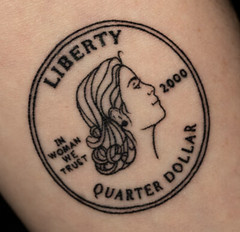 Britt Williams Baker, a Harvard Business School graduate and former consultant, had been offering friends how-to sessions on investing when she realized that many needed to start with the basics of budgeting. So, teaching alongside her that night was best friend Laurie-Anne King, a women's empowerment coach who had been on a personal finance journey of her own: paying off $40,000 of debt.
Britt Williams Baker, a Harvard Business School graduate and former consultant, had been offering friends how-to sessions on investing when she realized that many needed to start with the basics of budgeting. So, teaching alongside her that night was best friend Laurie-Anne King, a women's empowerment coach who had been on a personal finance journey of her own: paying off $40,000 of debt.
The name Baker gave the circle? Dow Janes.
In the years since, Dow Janes has grown from a small group of friends helping friends into a business that offers paid online courses. Baker and King teach women across the United States and Canada how to take control of their money, with a bold mission at the heart of their work.
Have any of our readers gotten or seen a new money-themed tattoo? Show us your tats! -Editor
To read the complete article, see:
The wealth transfer from baby boomers mostly benefits women
(https://www.washingtonpost.com/business/2024/01/16/women-economic-power-demographic-shifts/)








